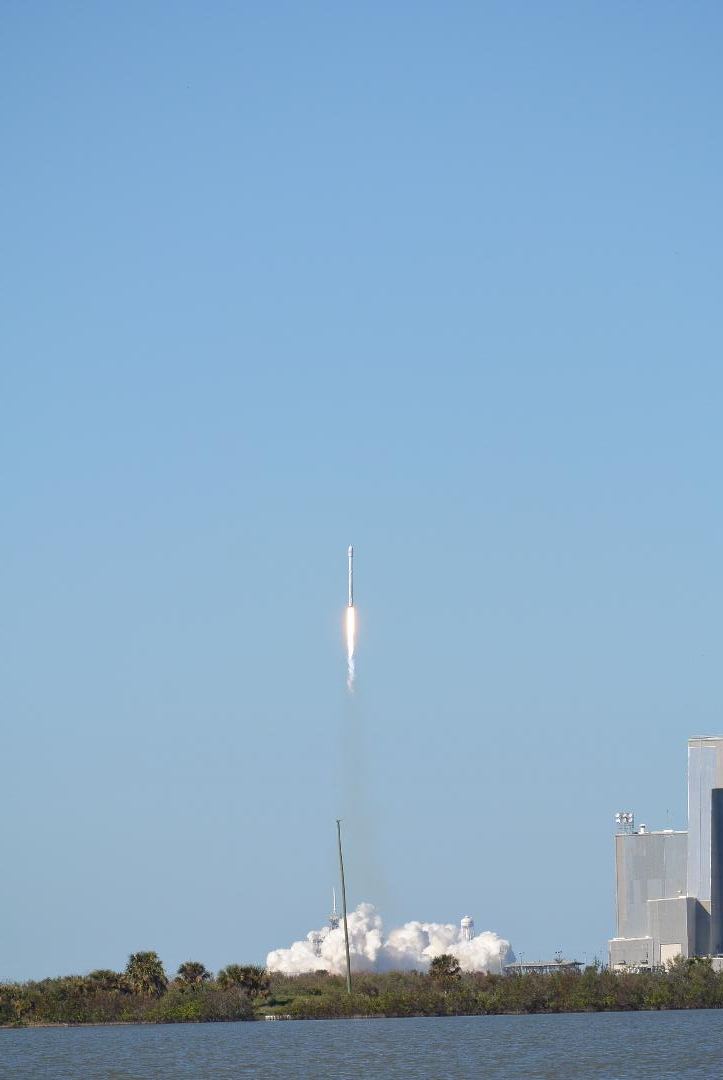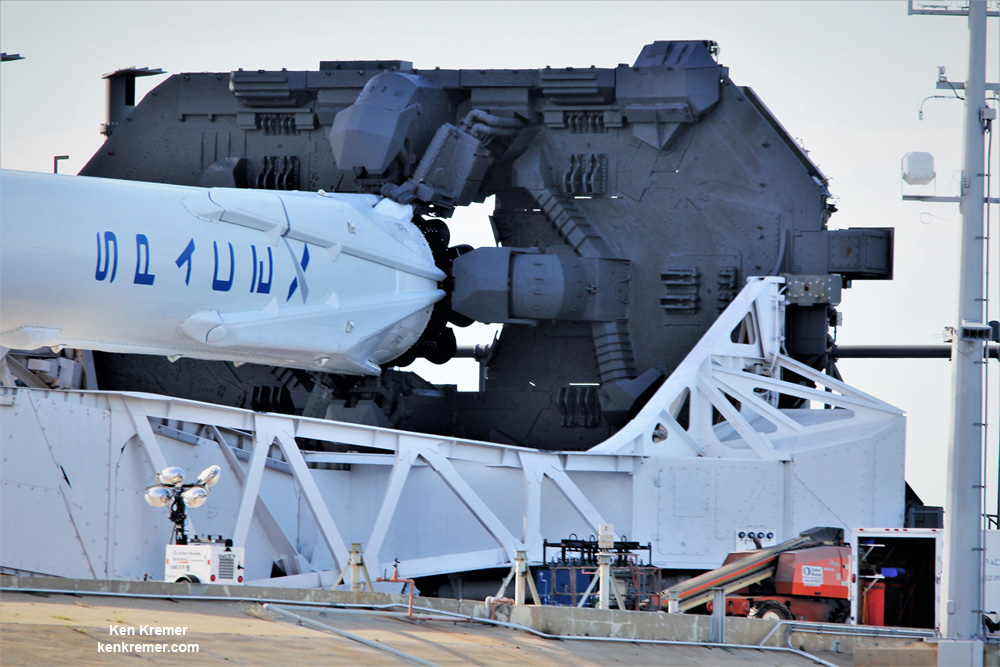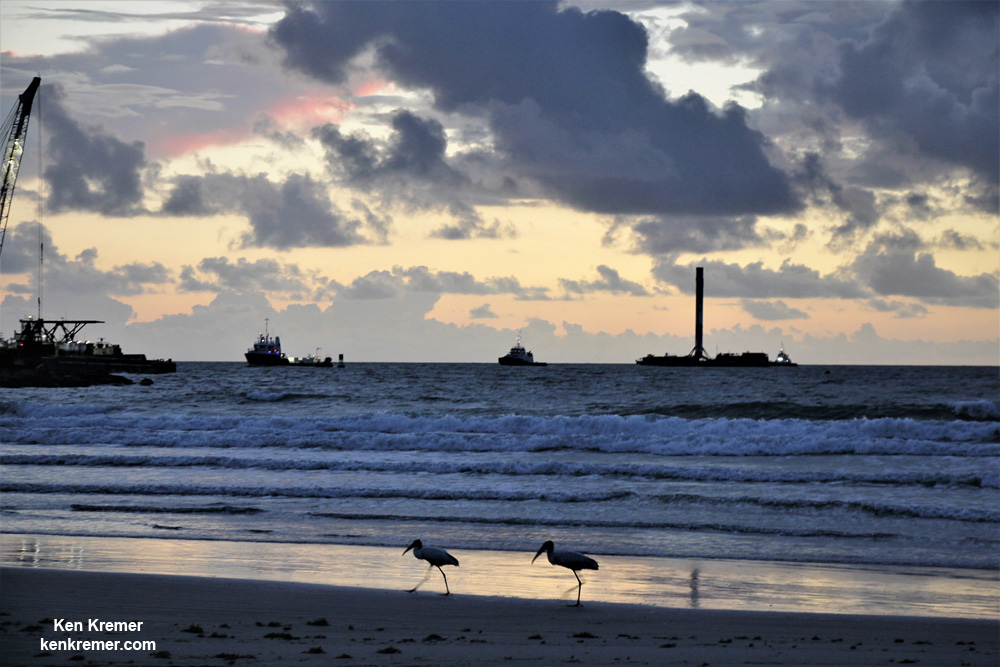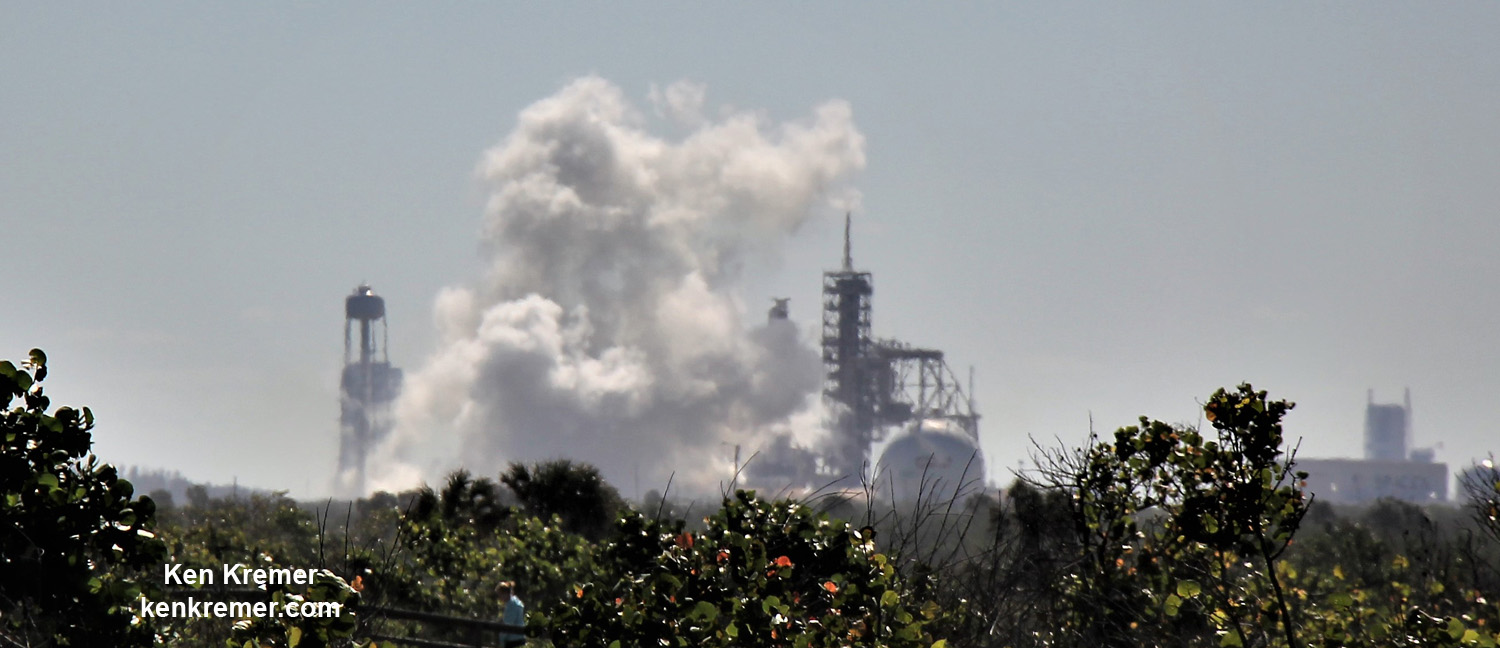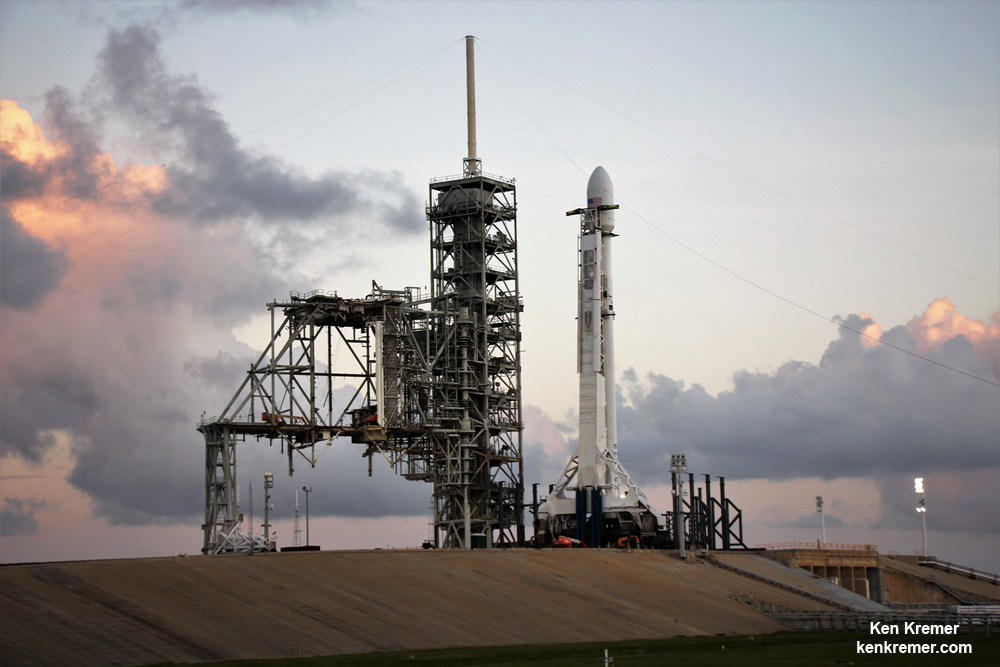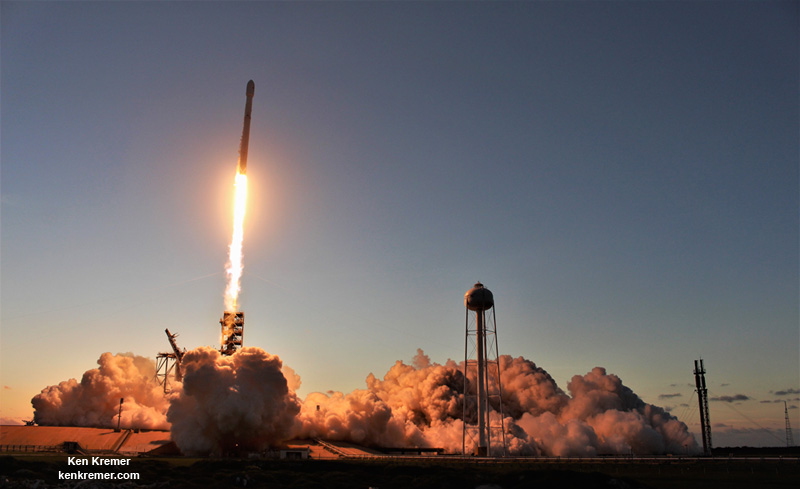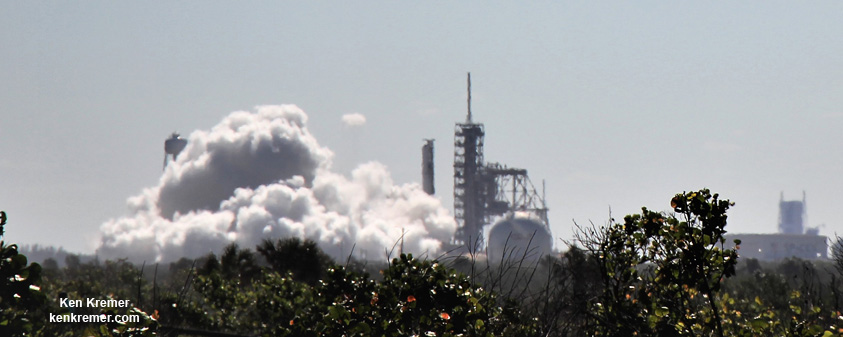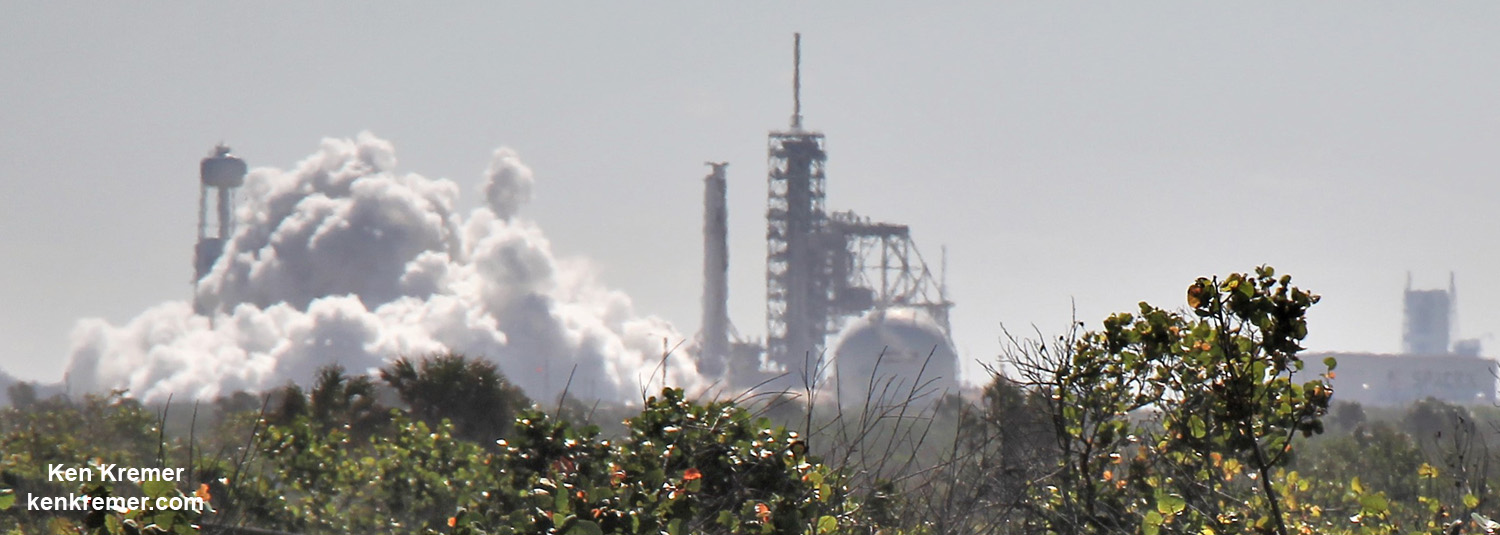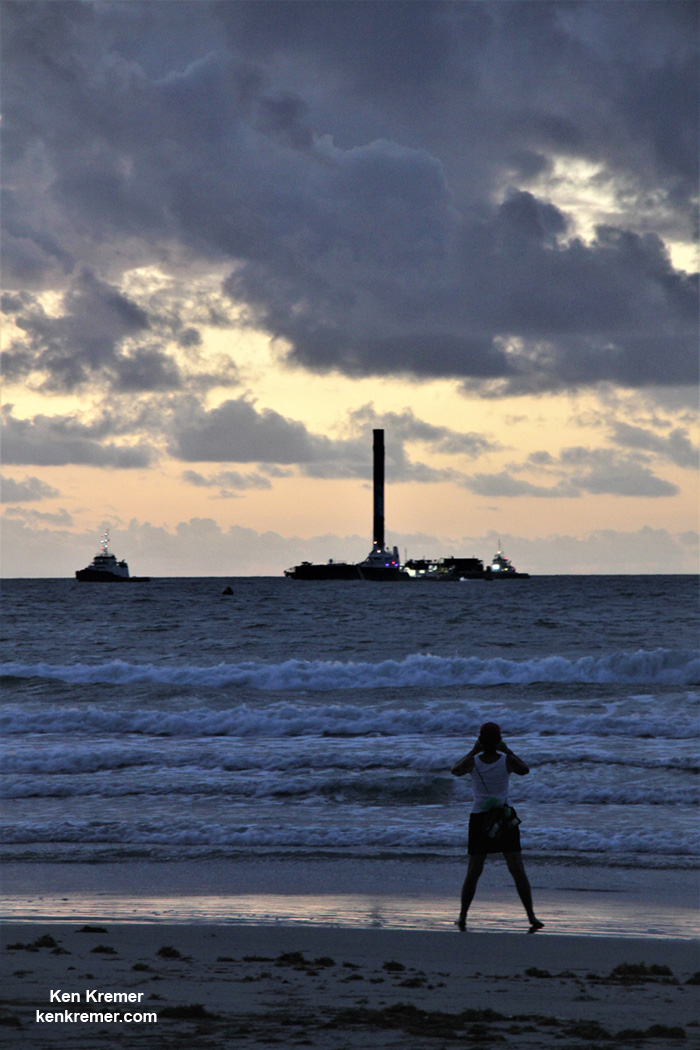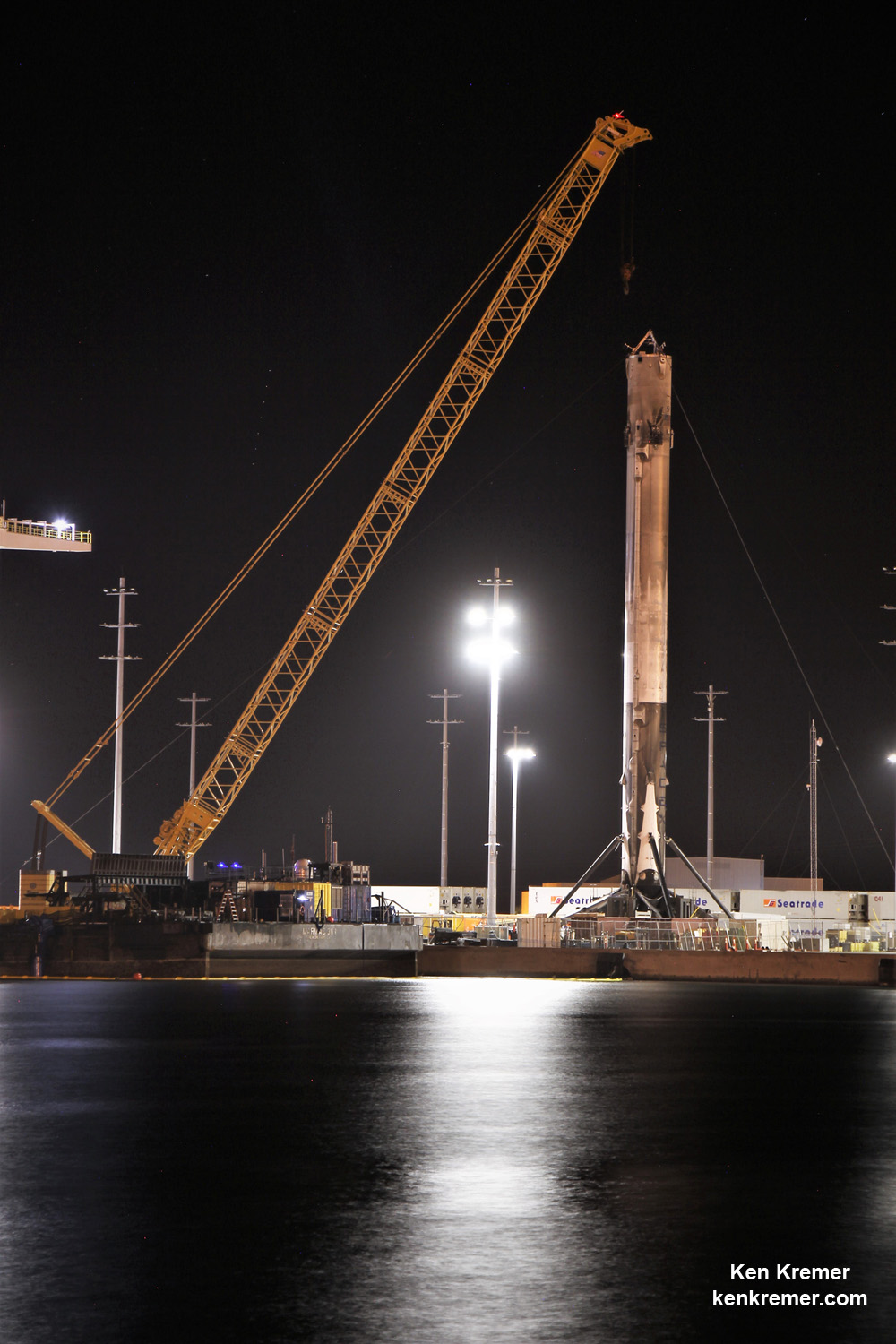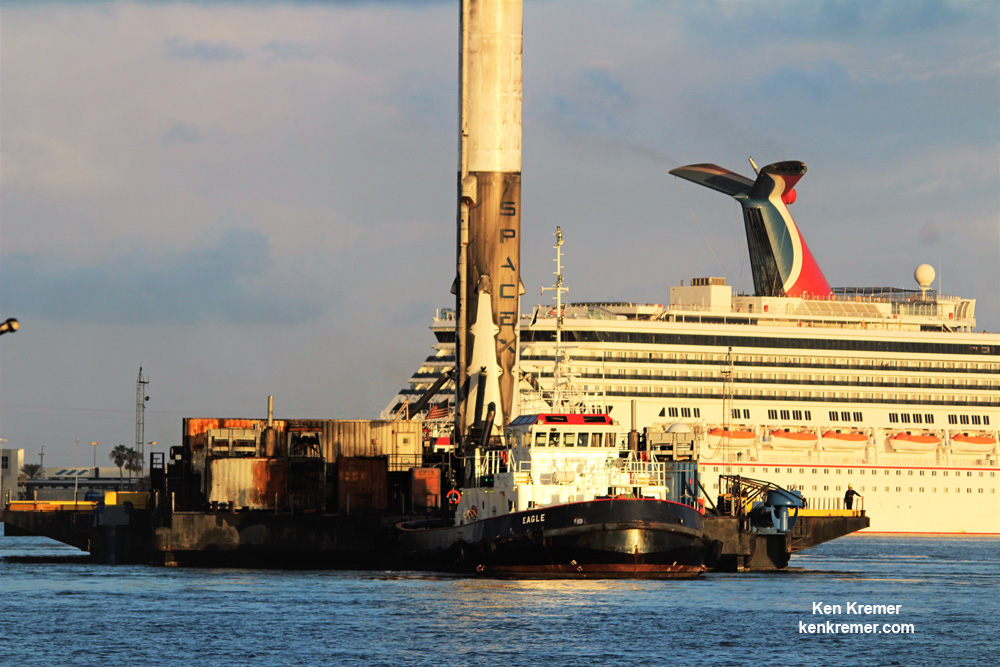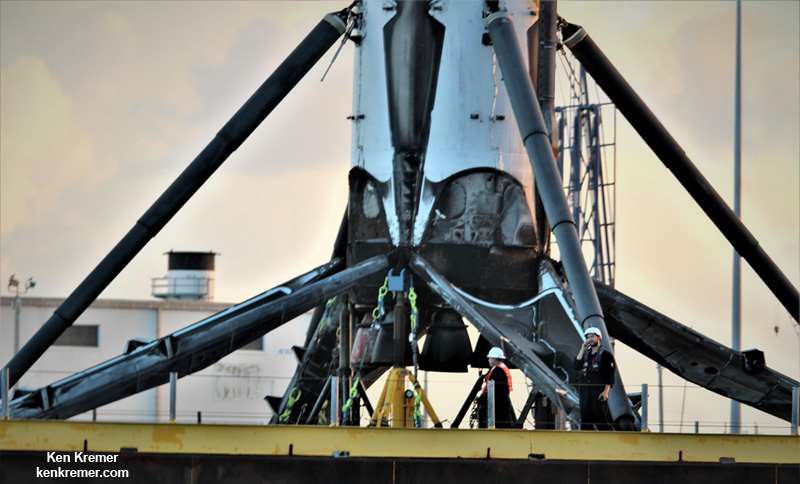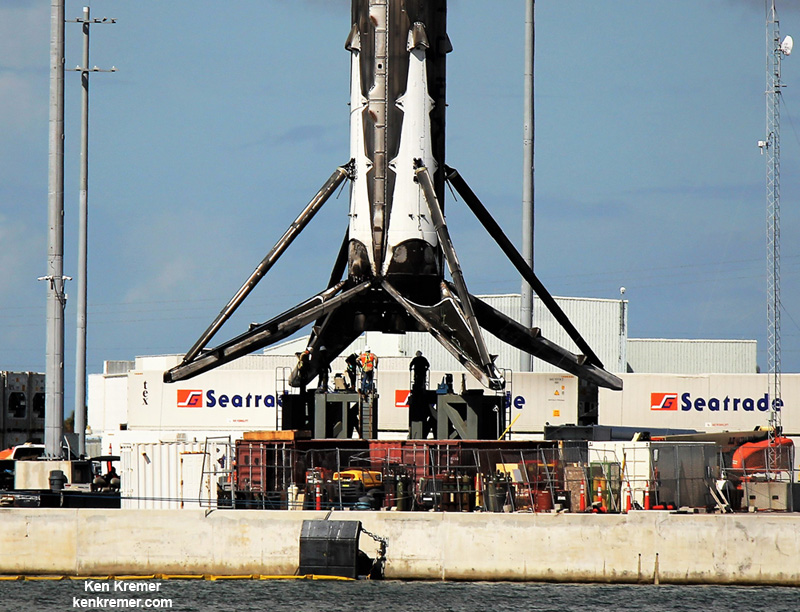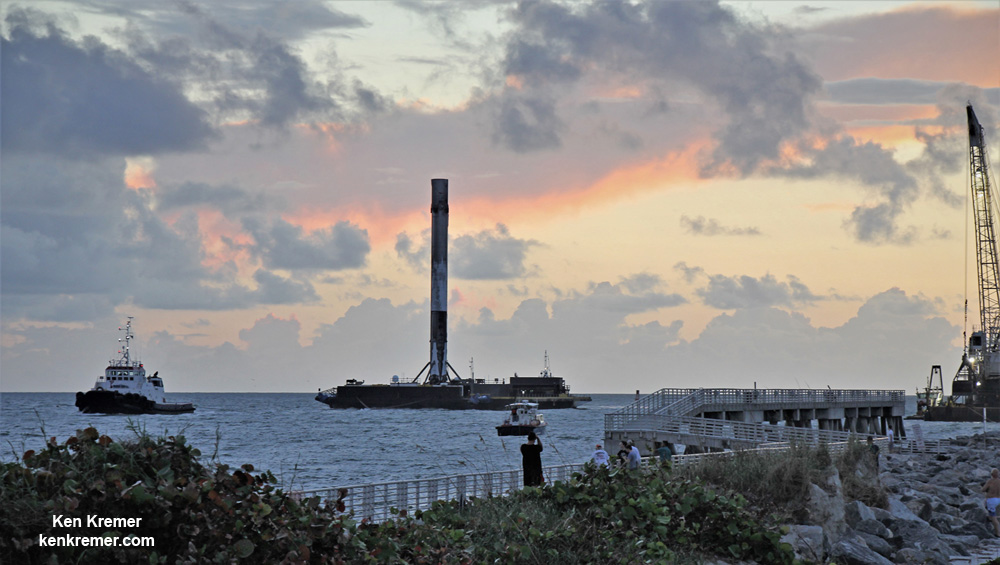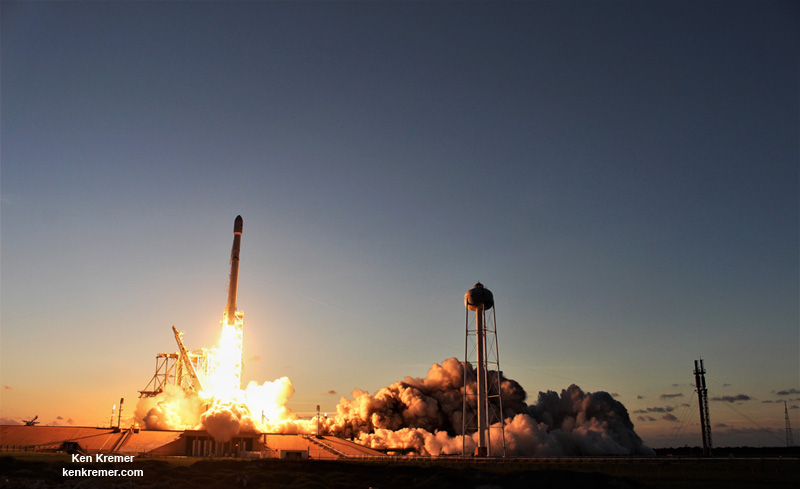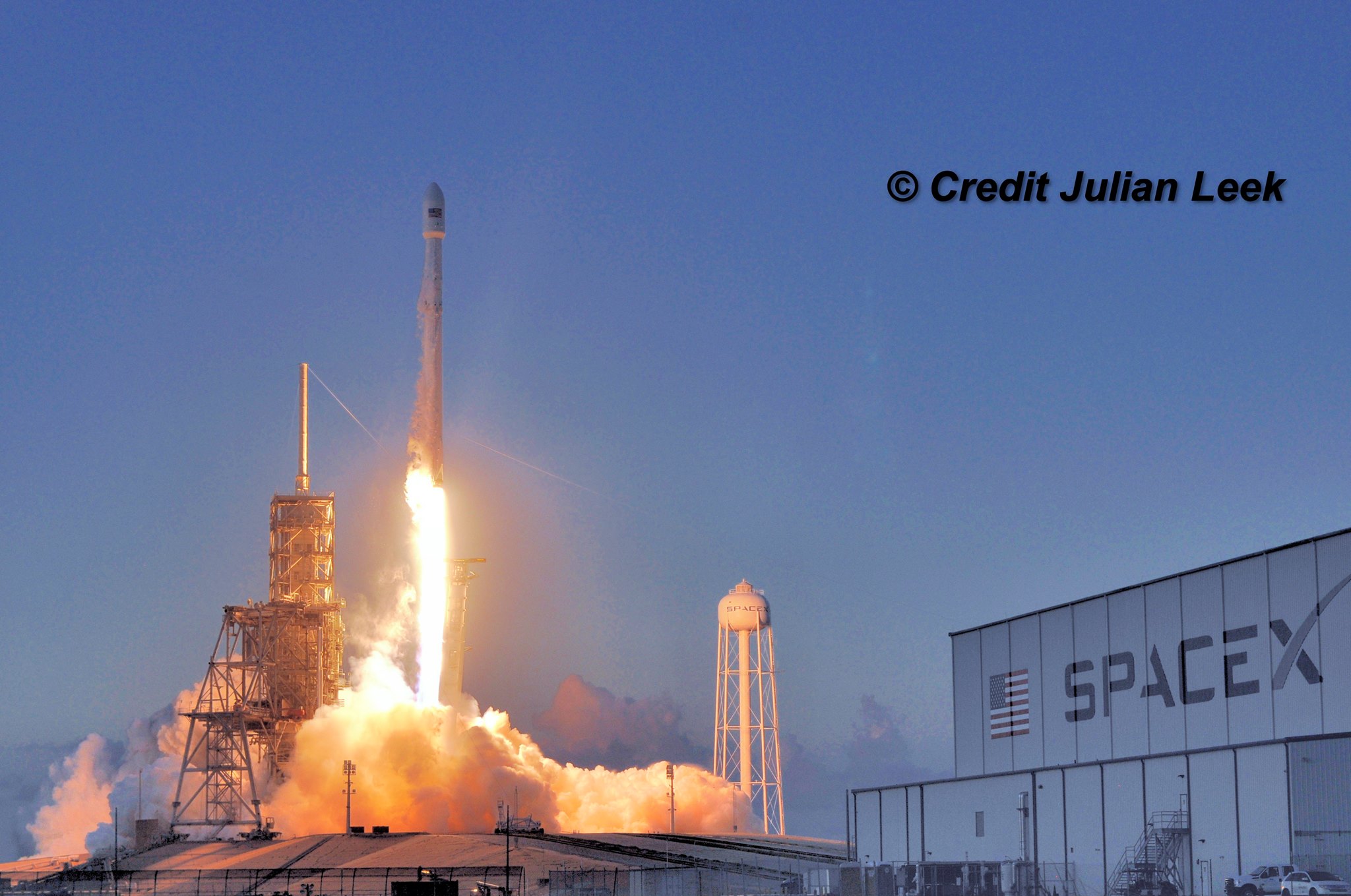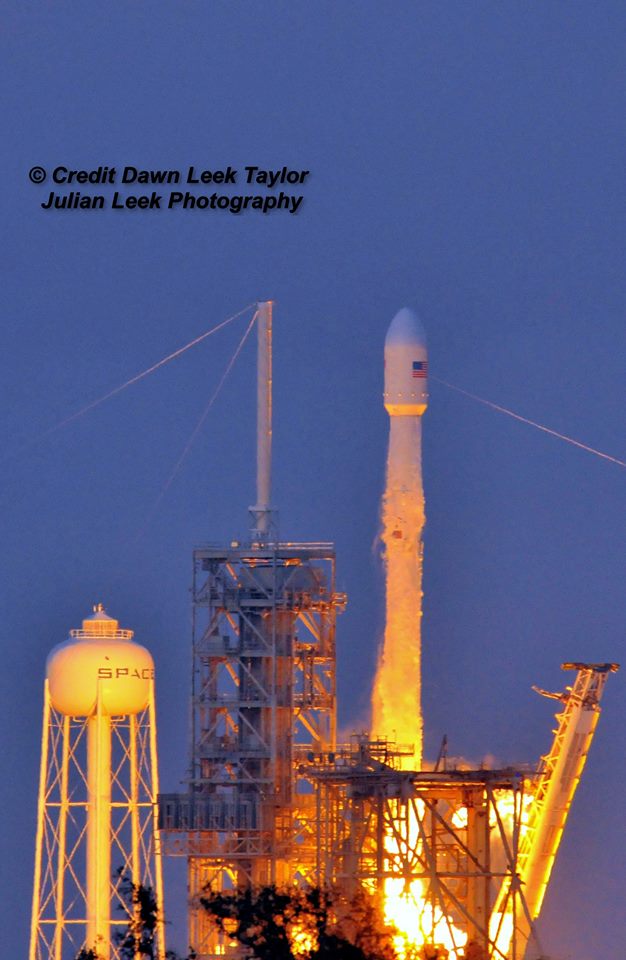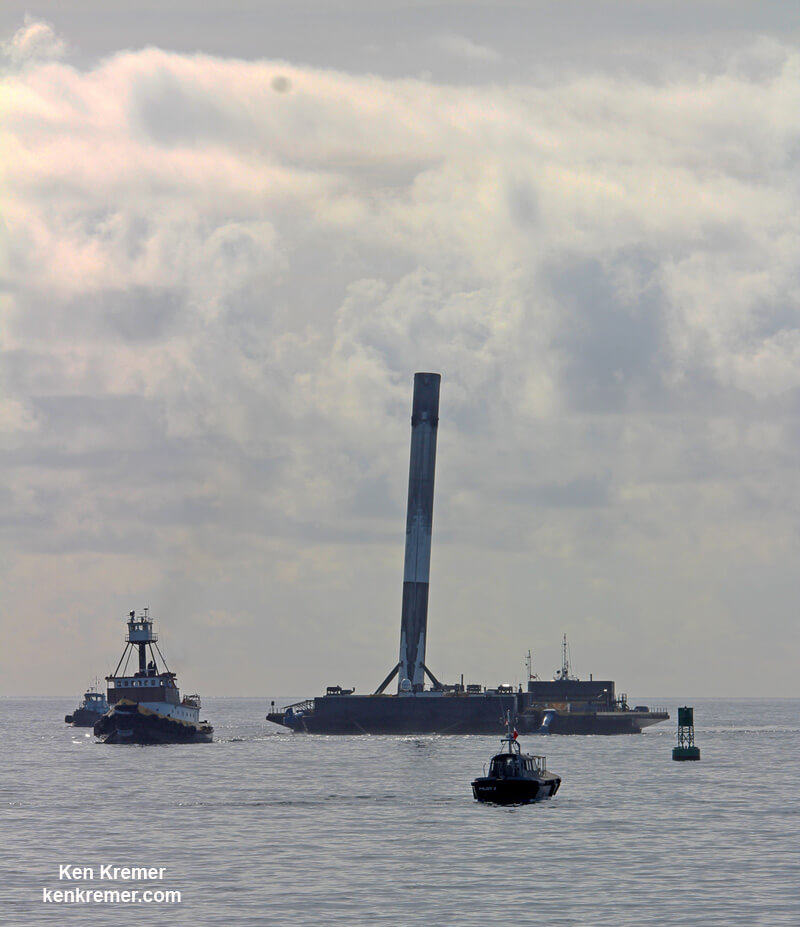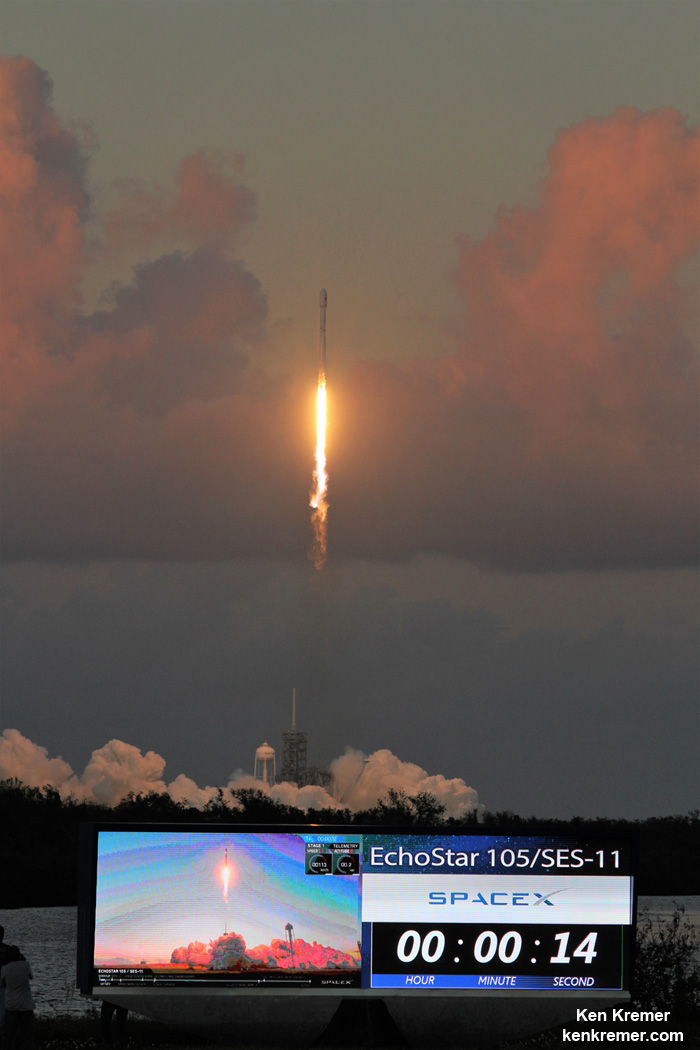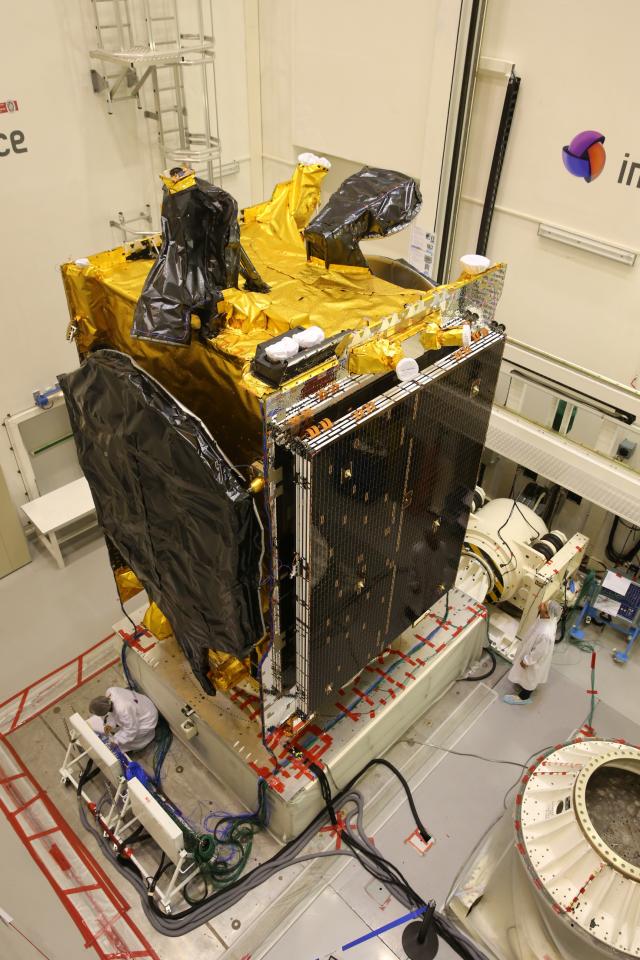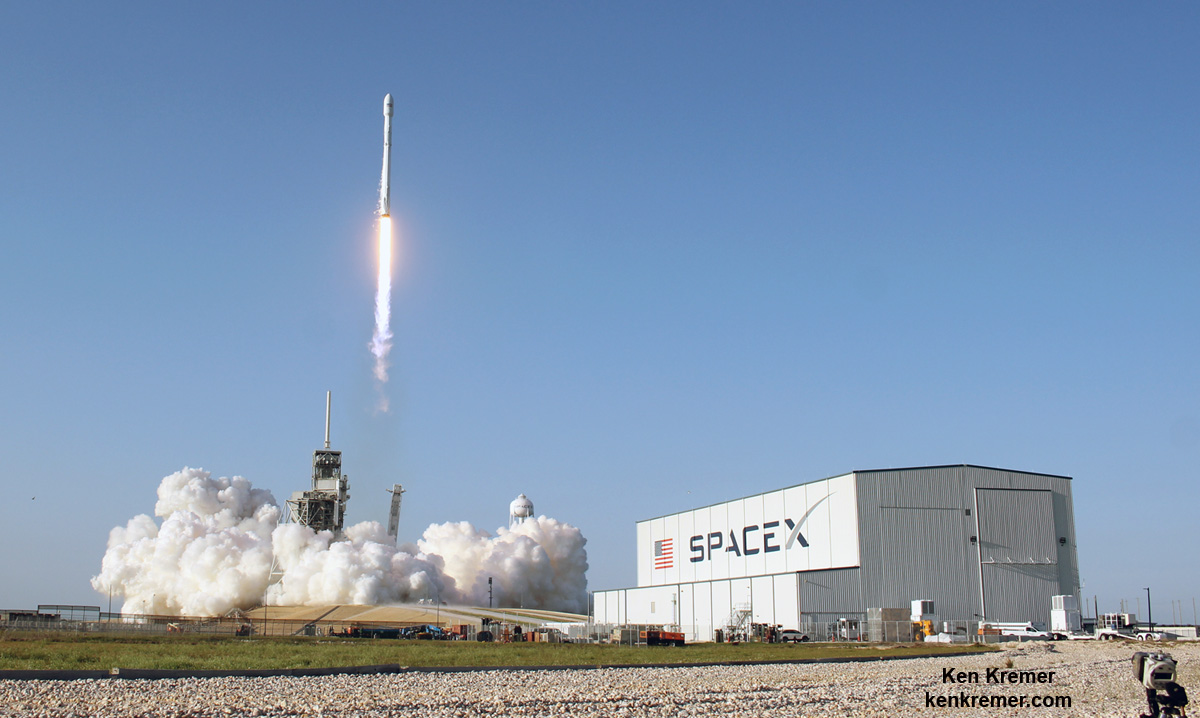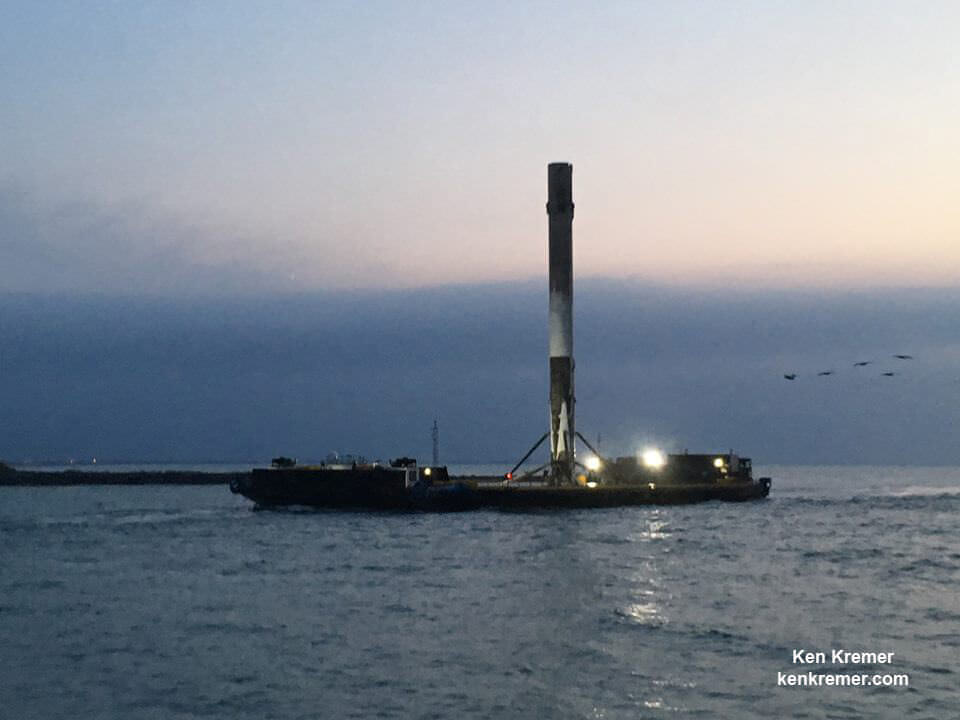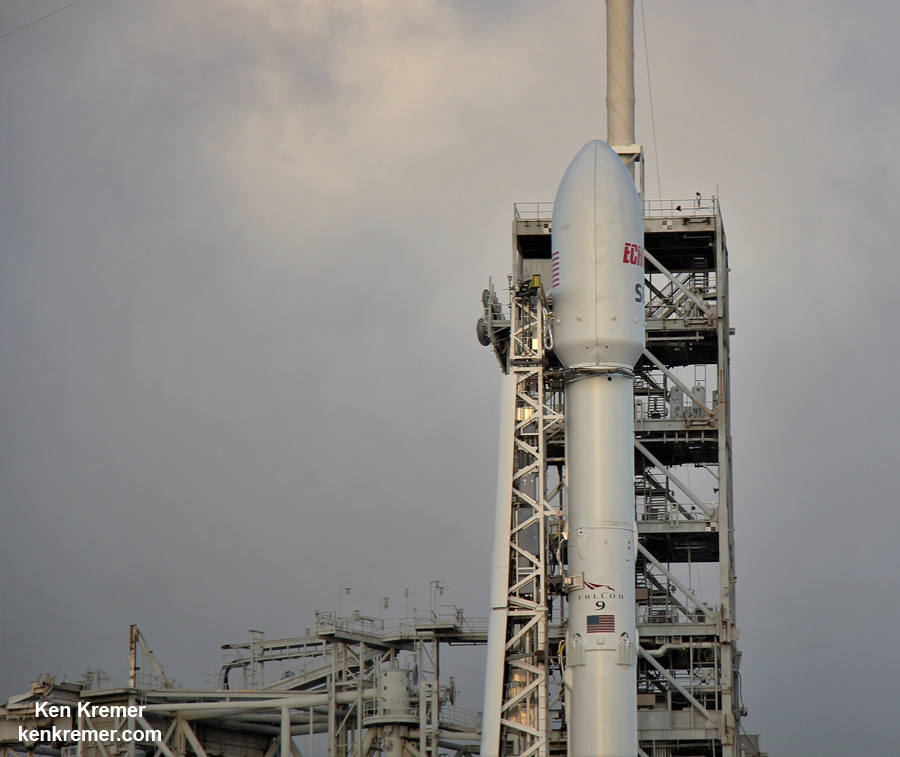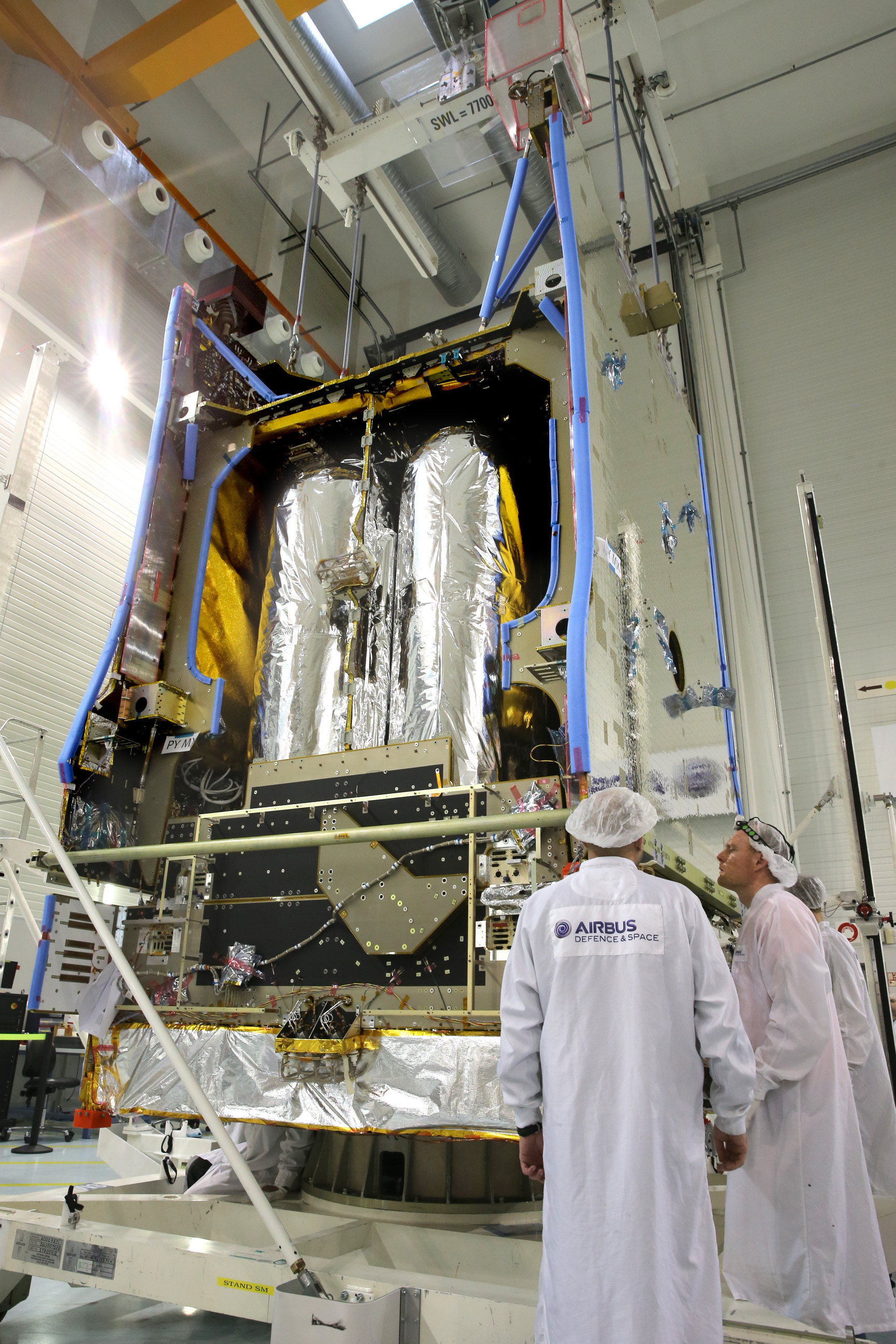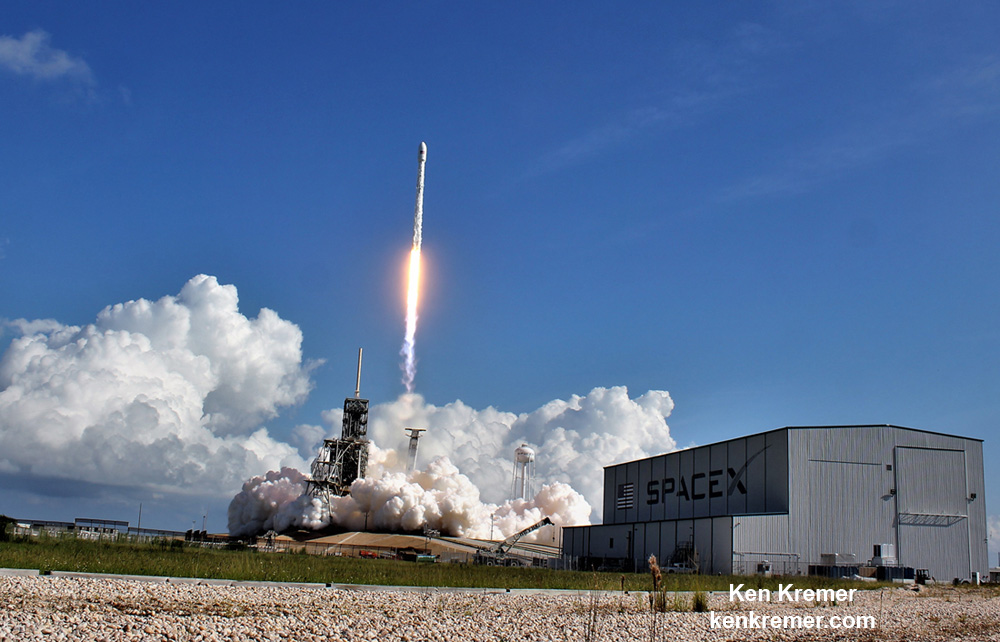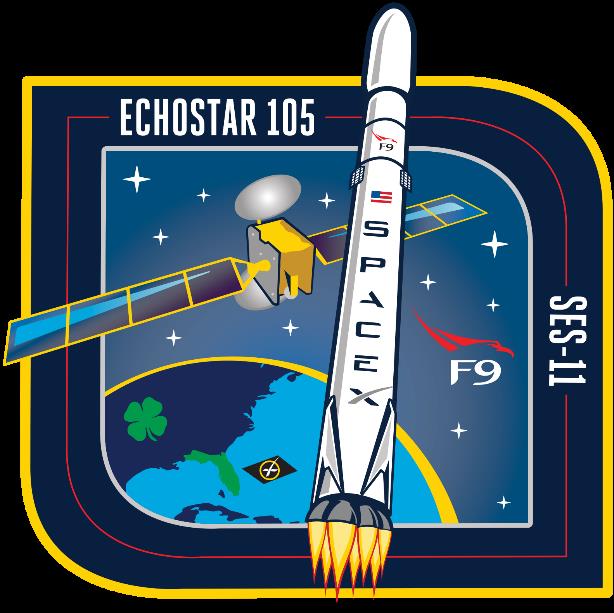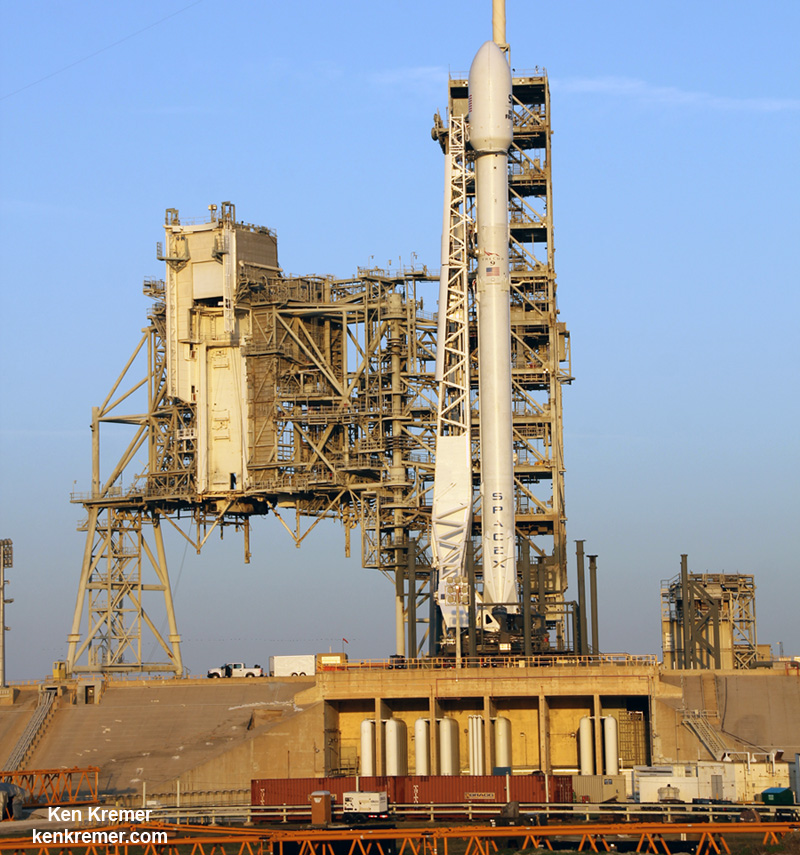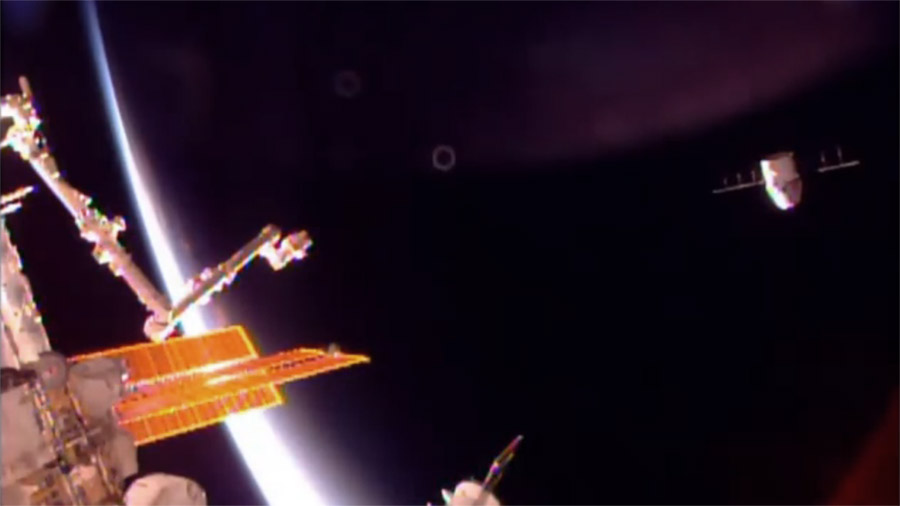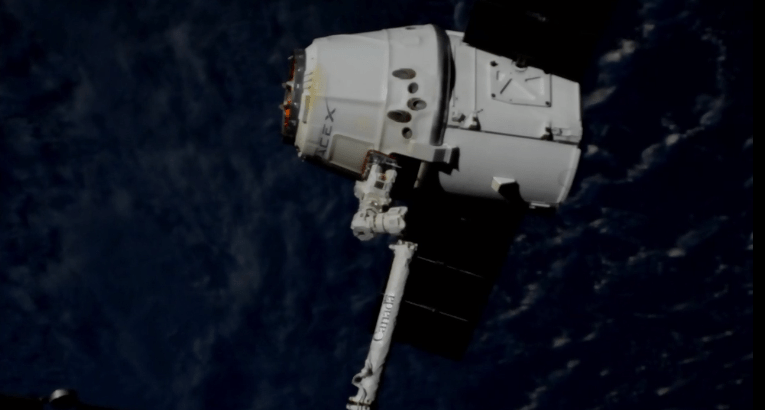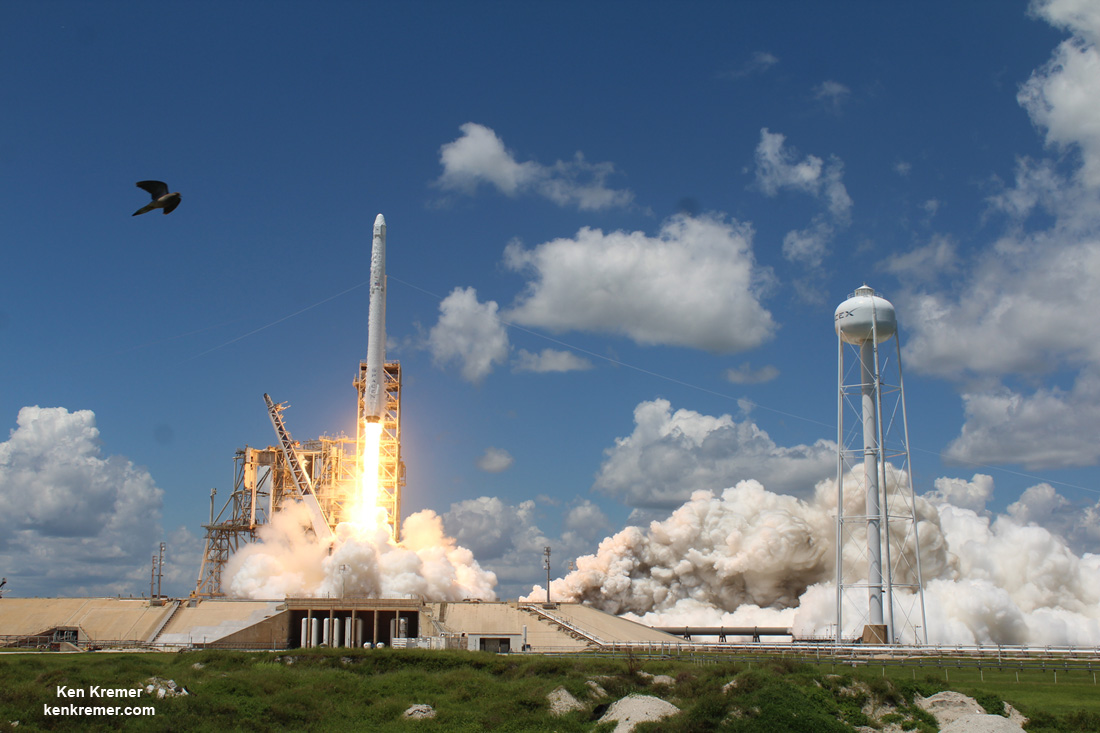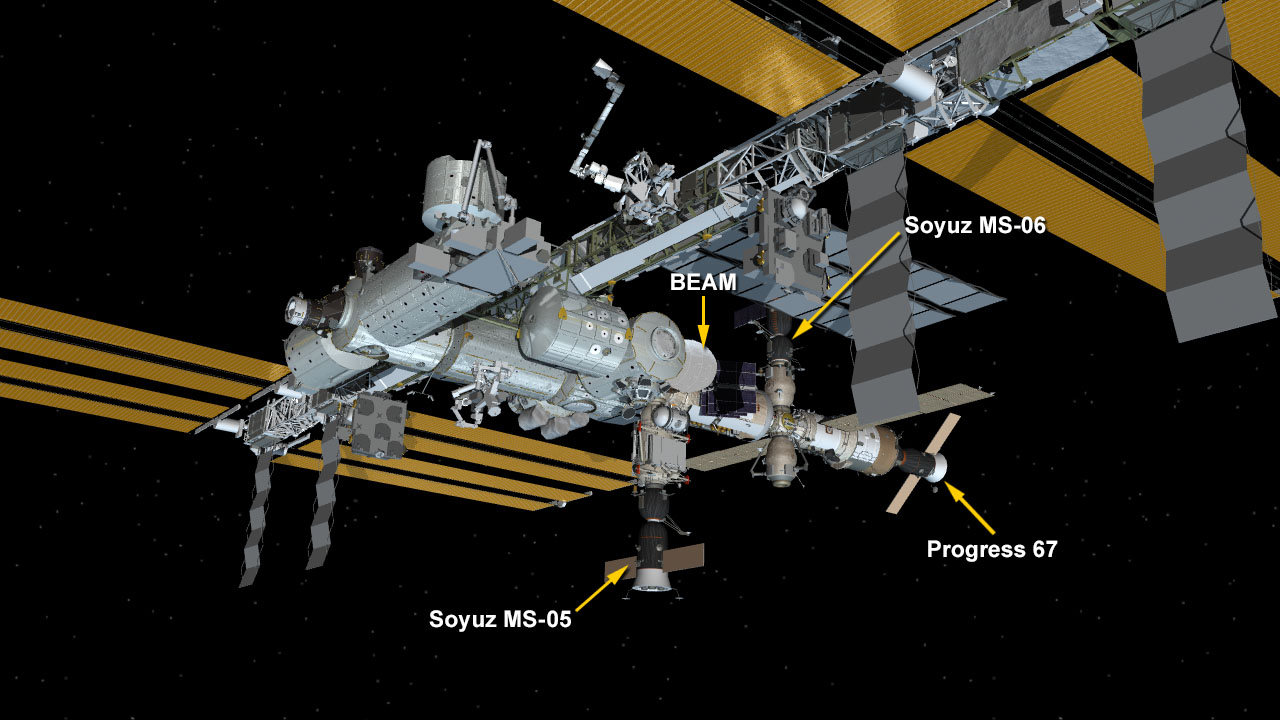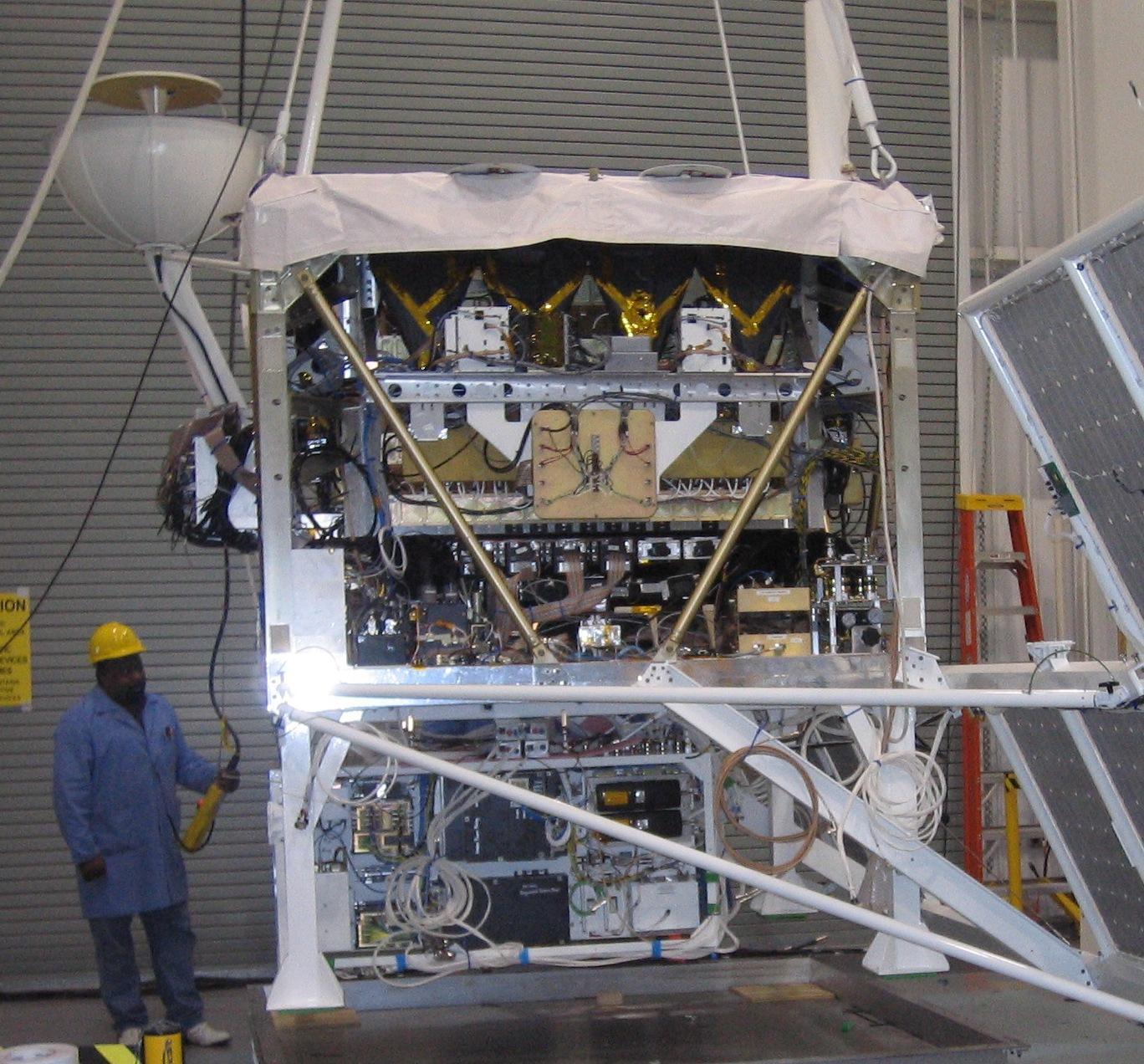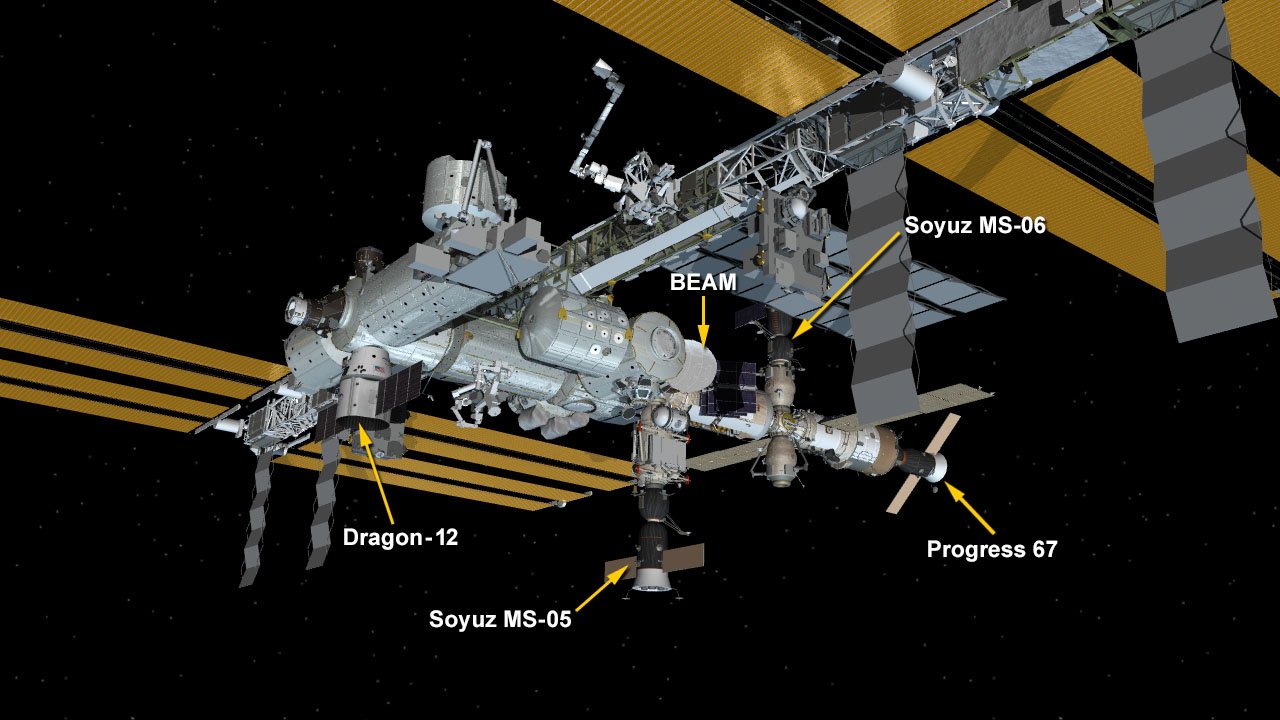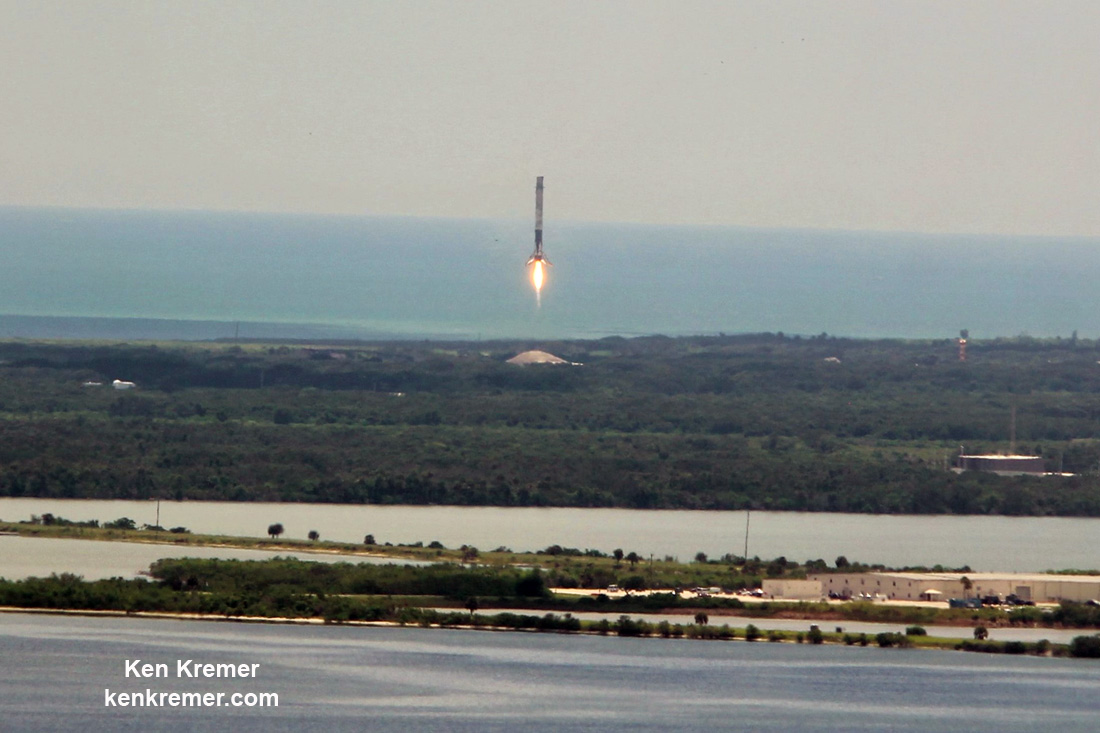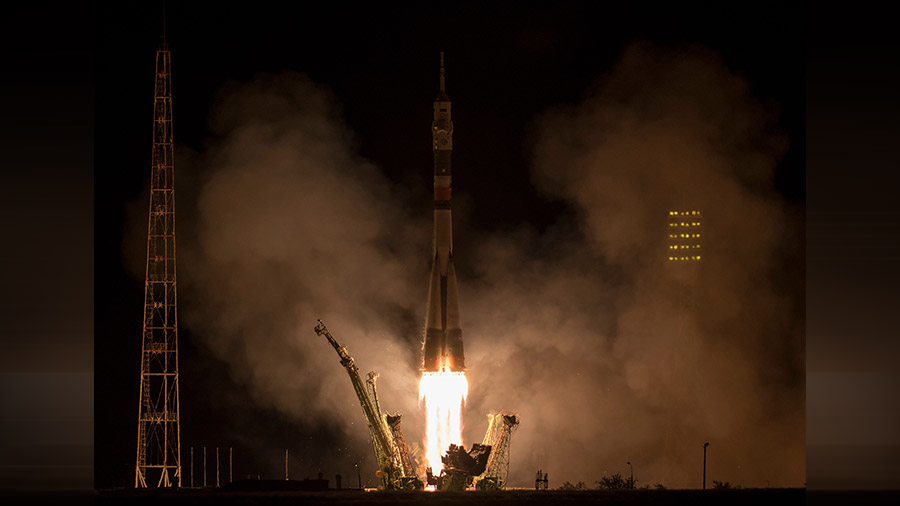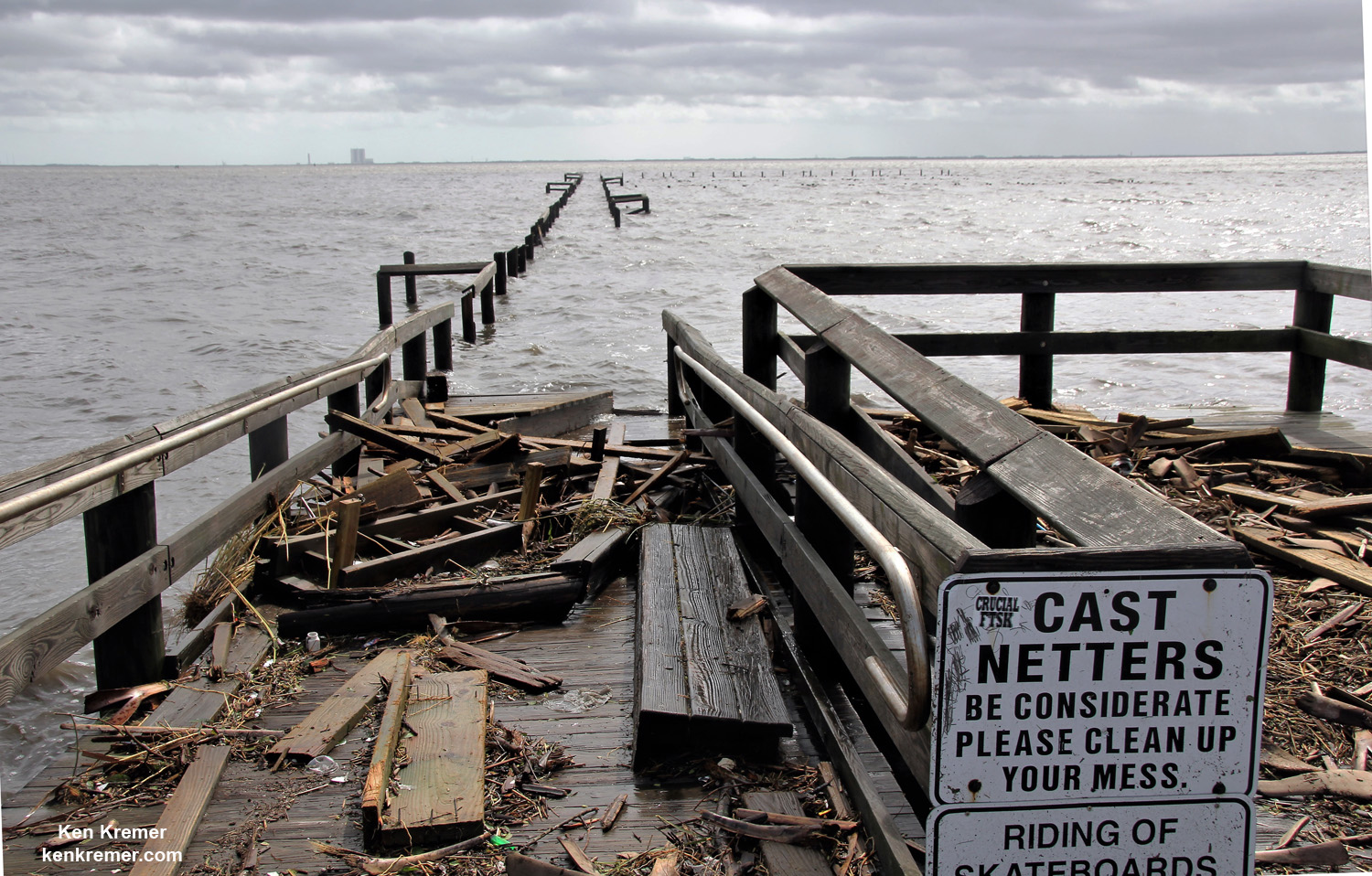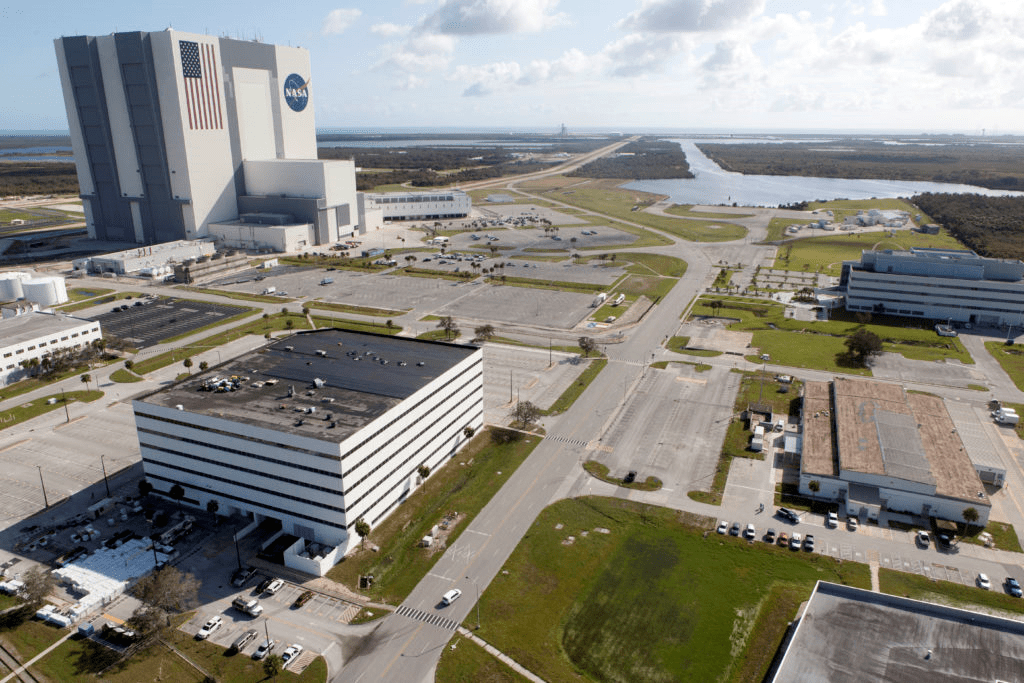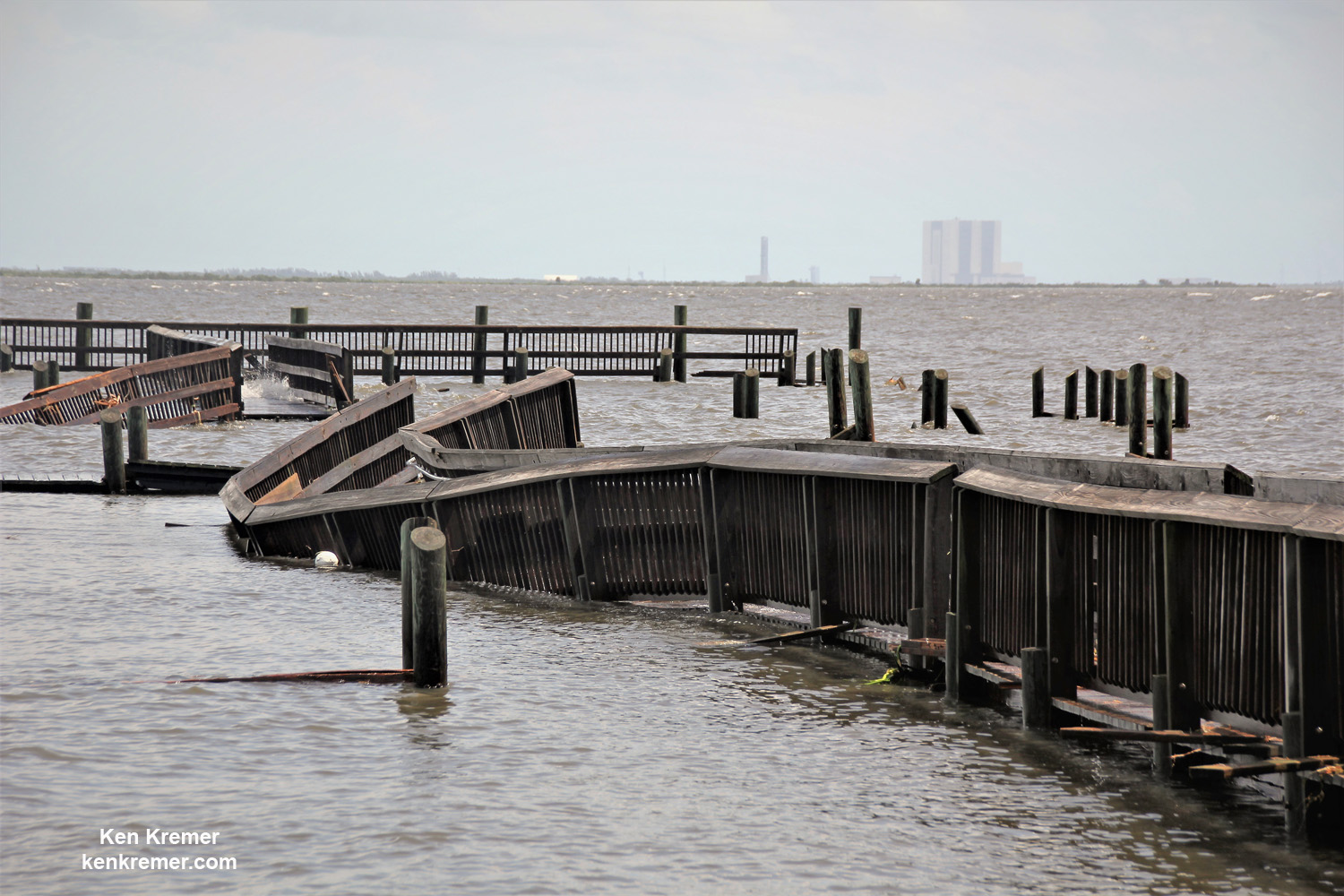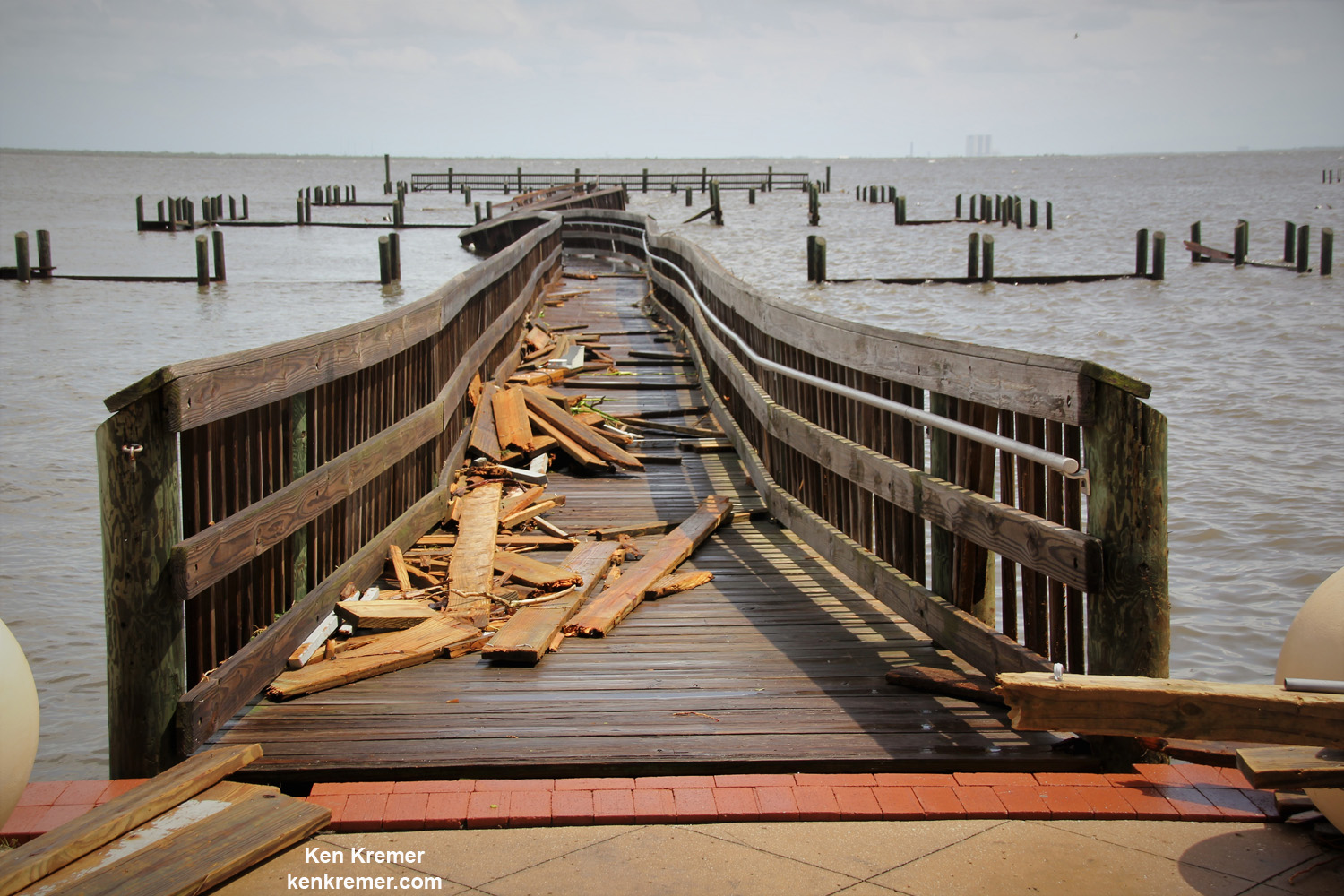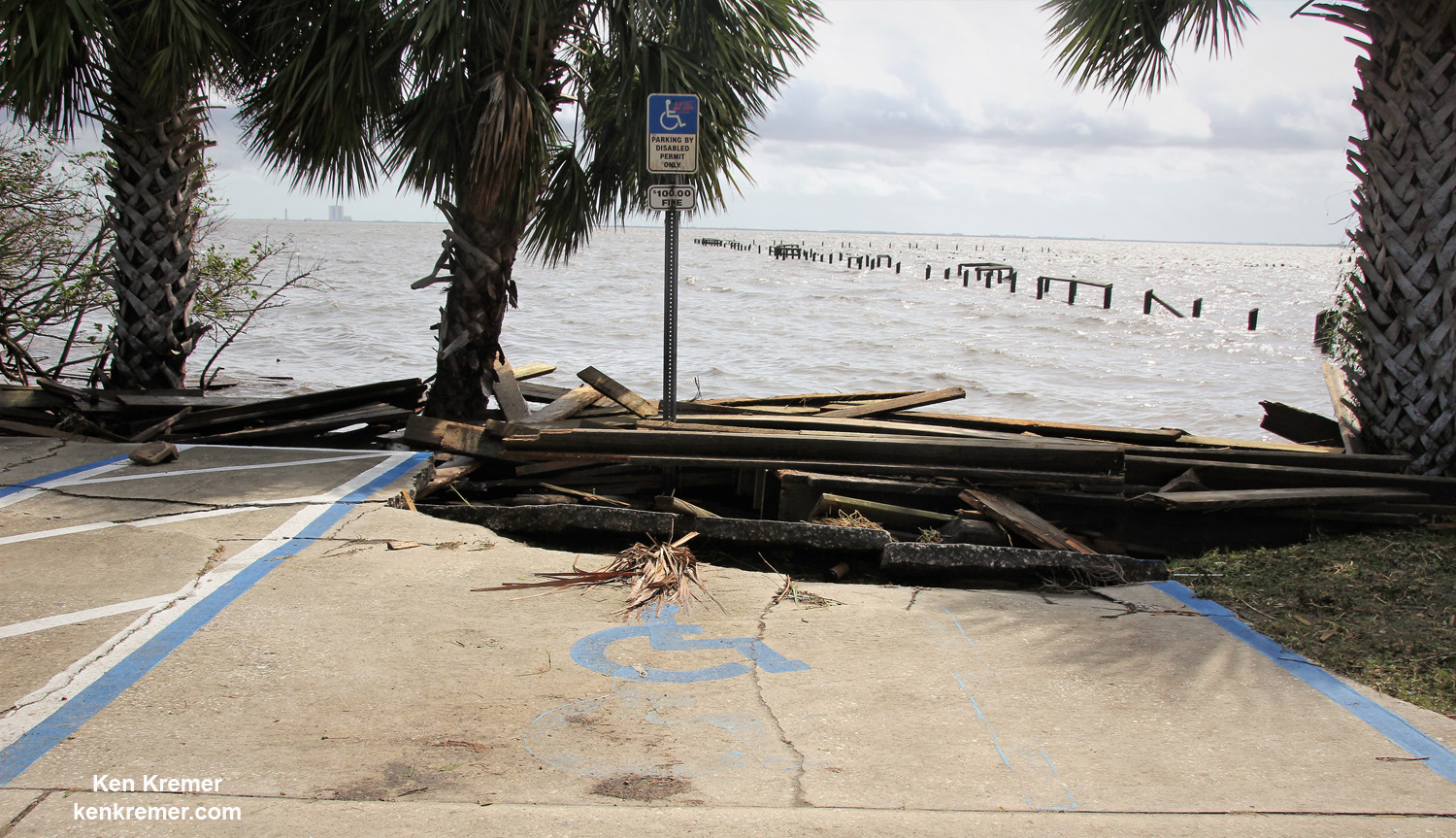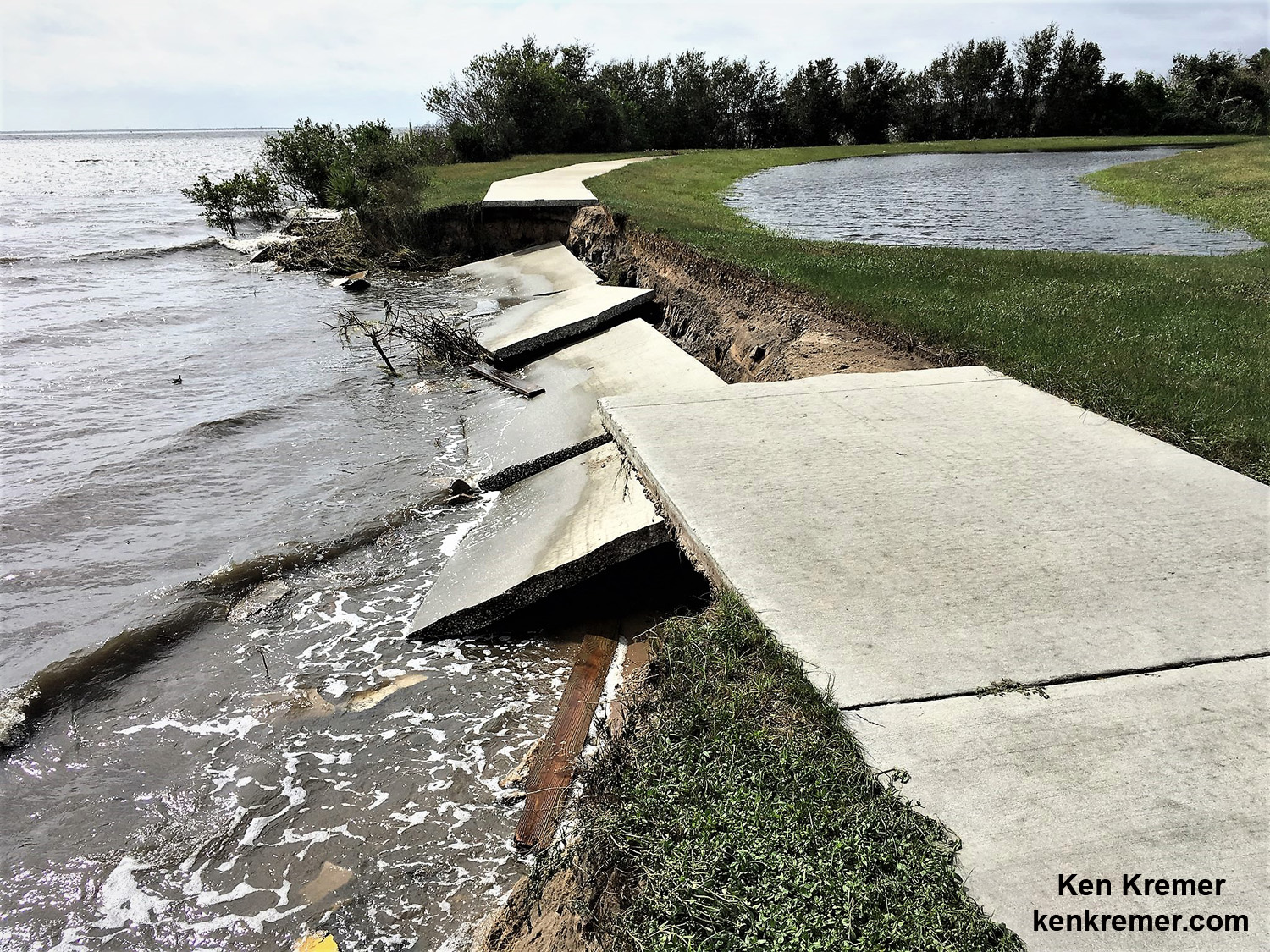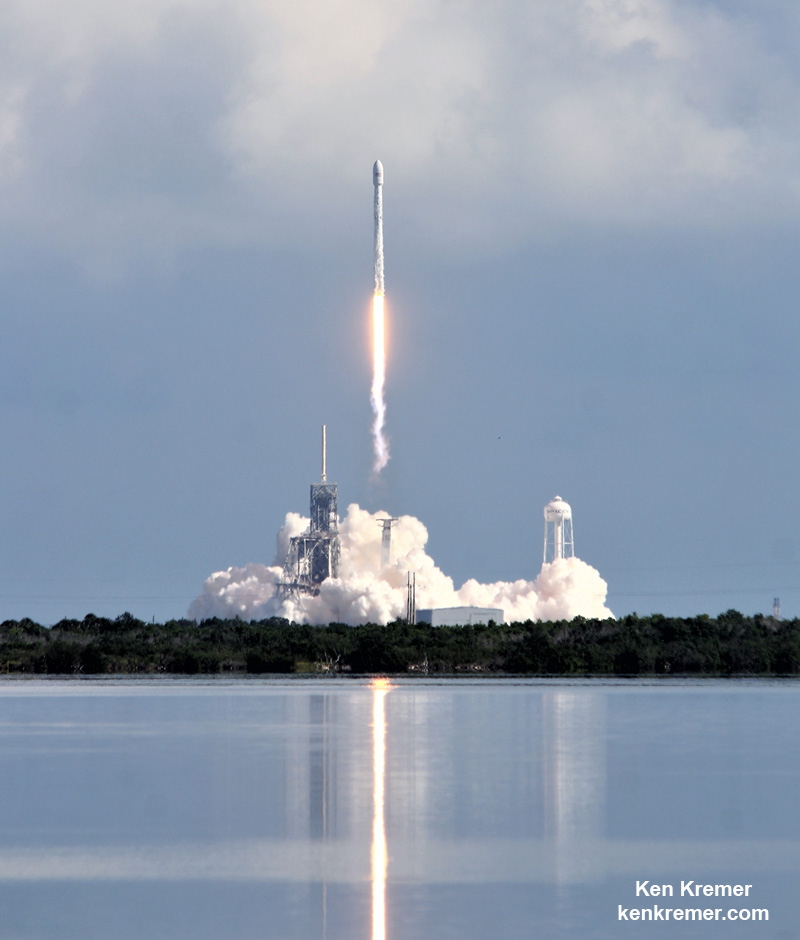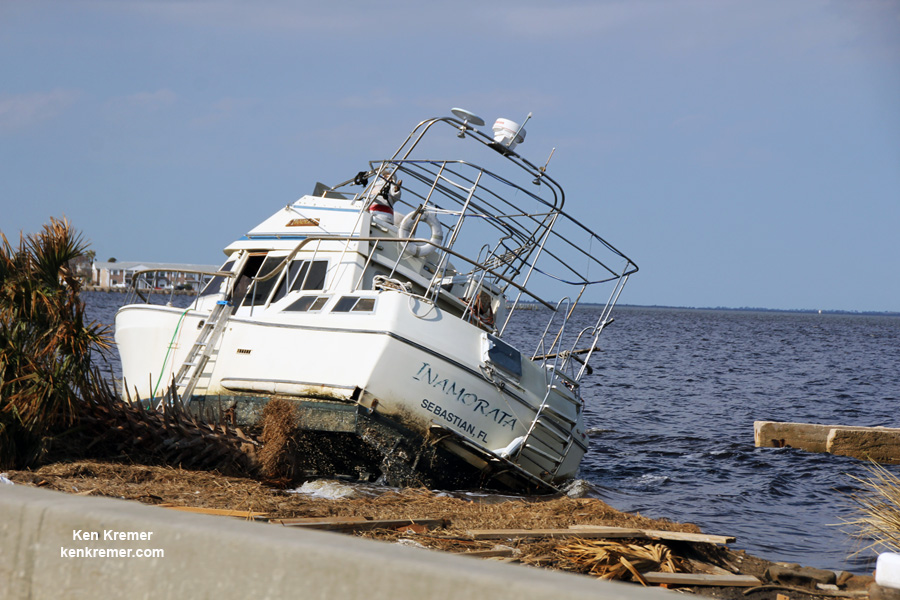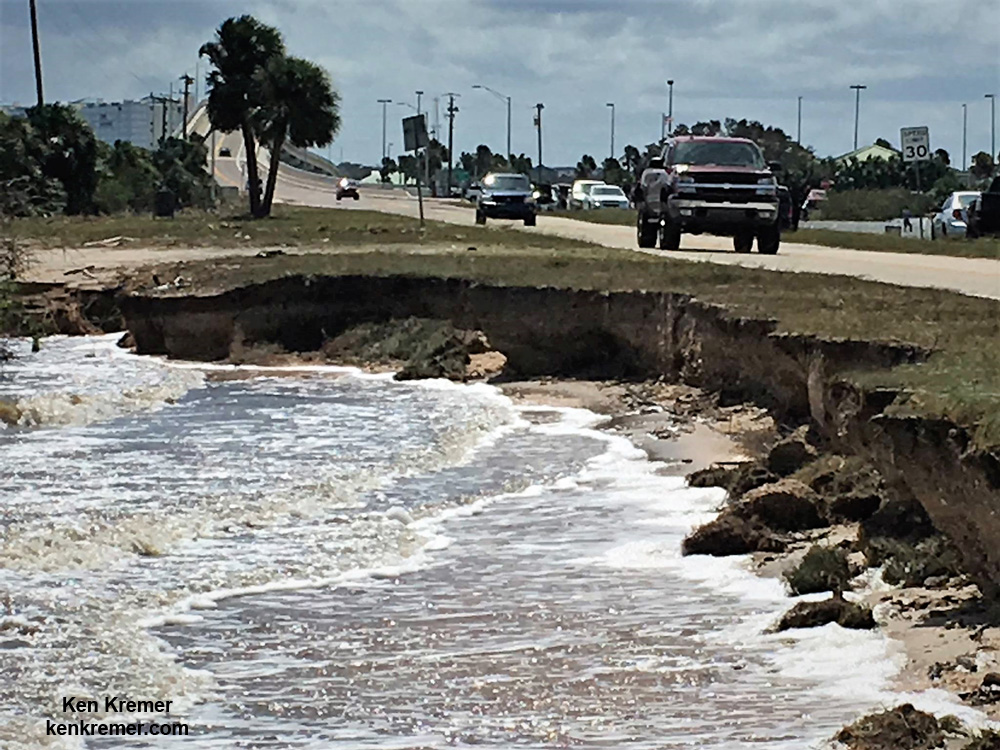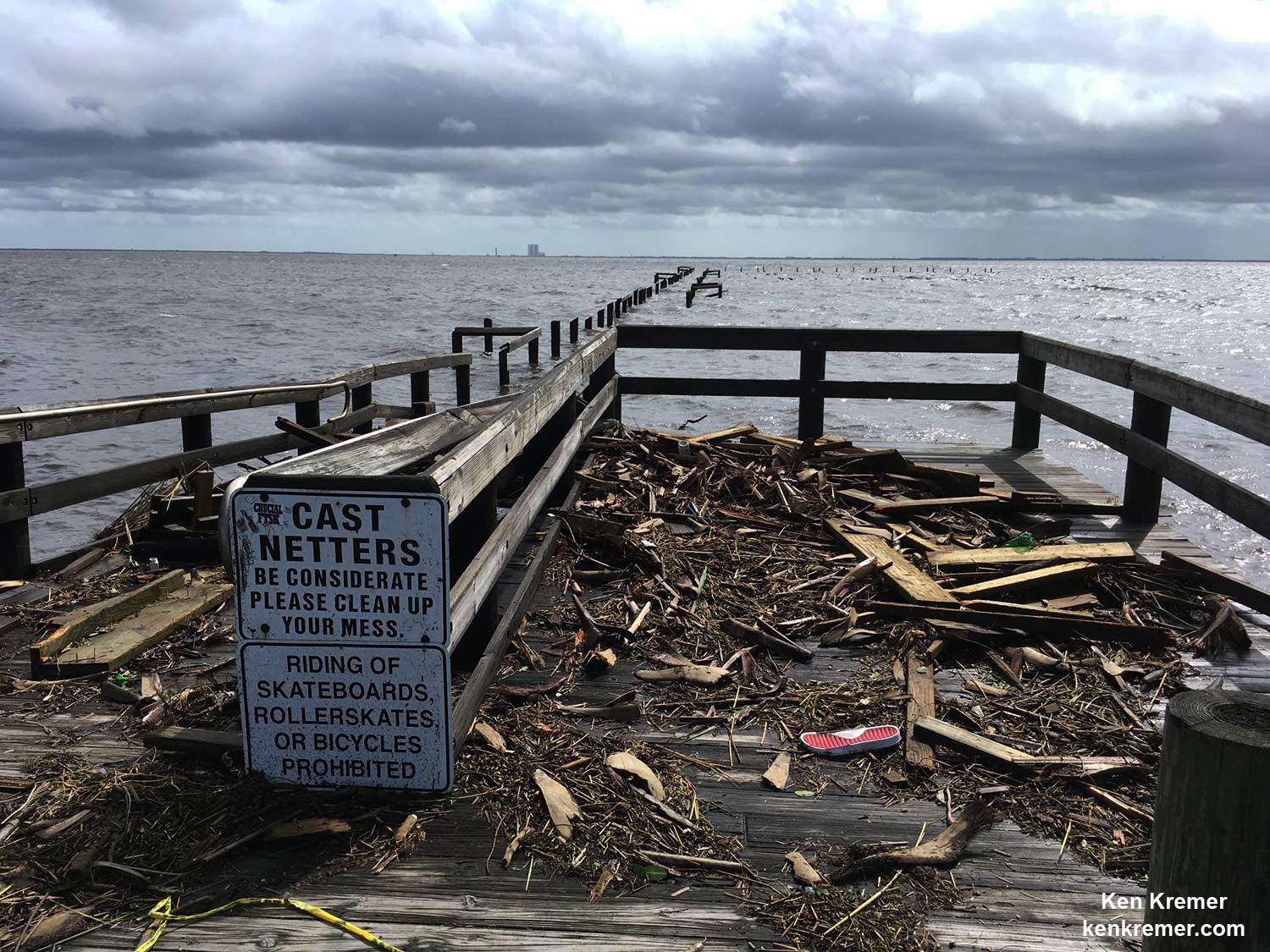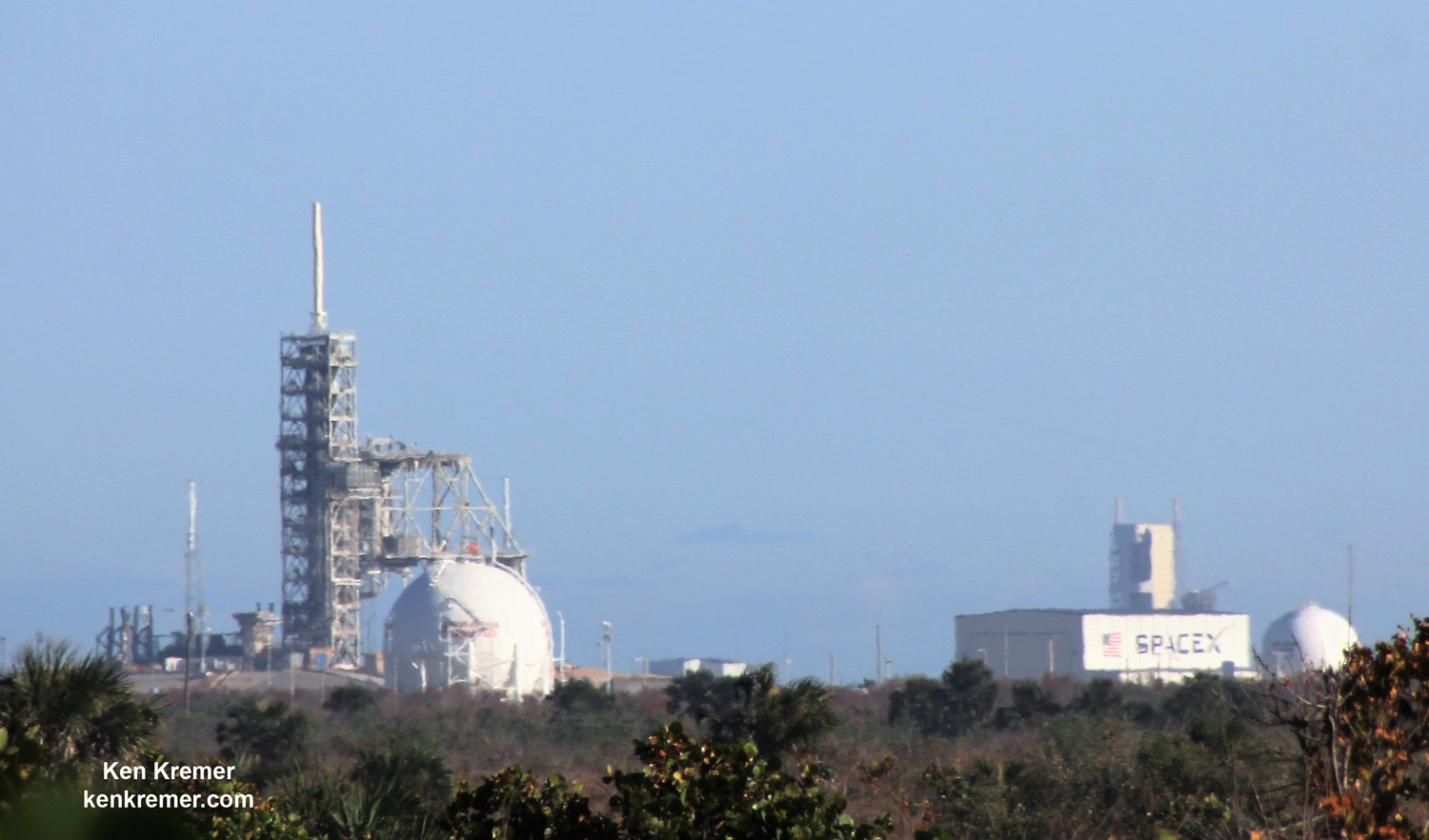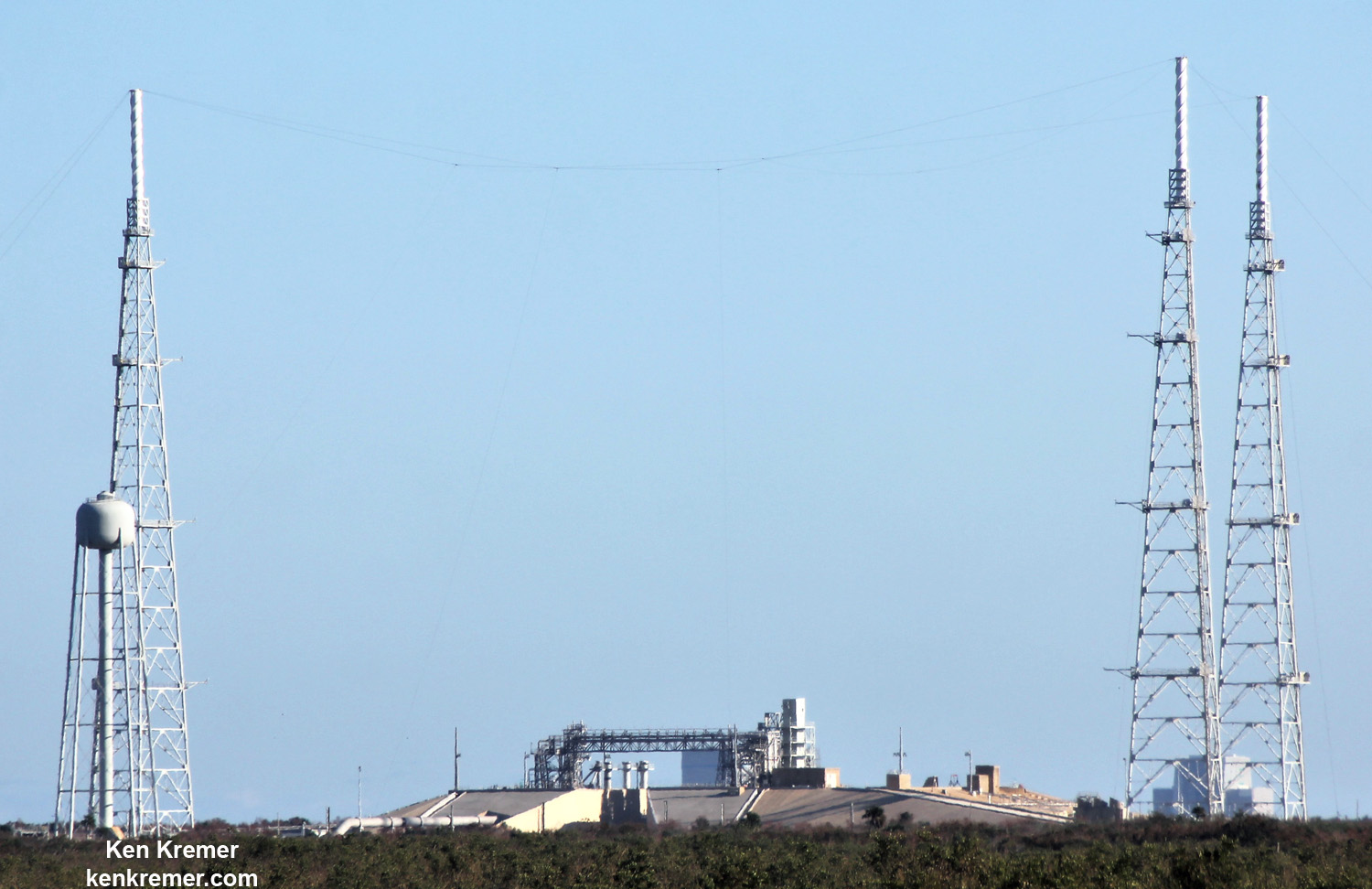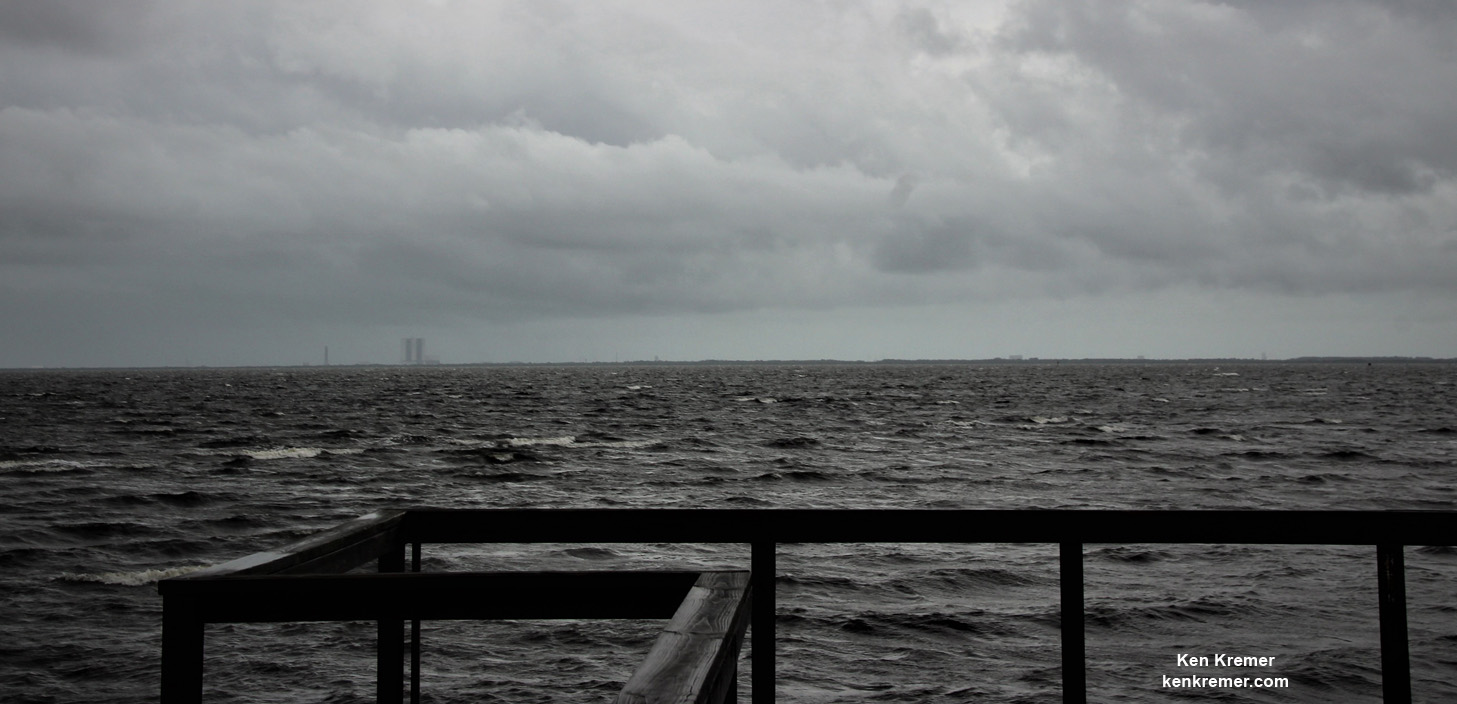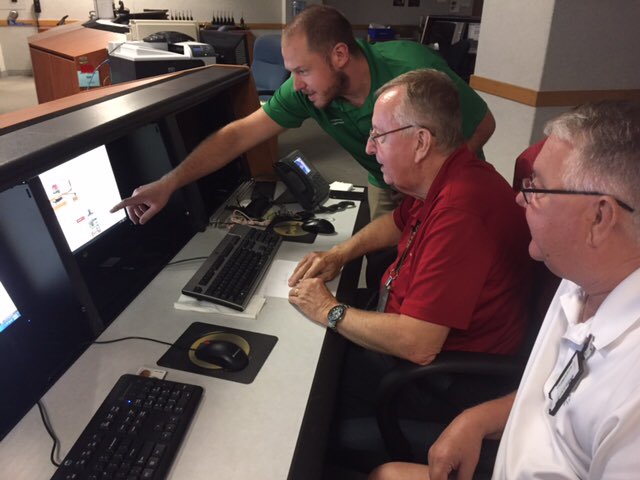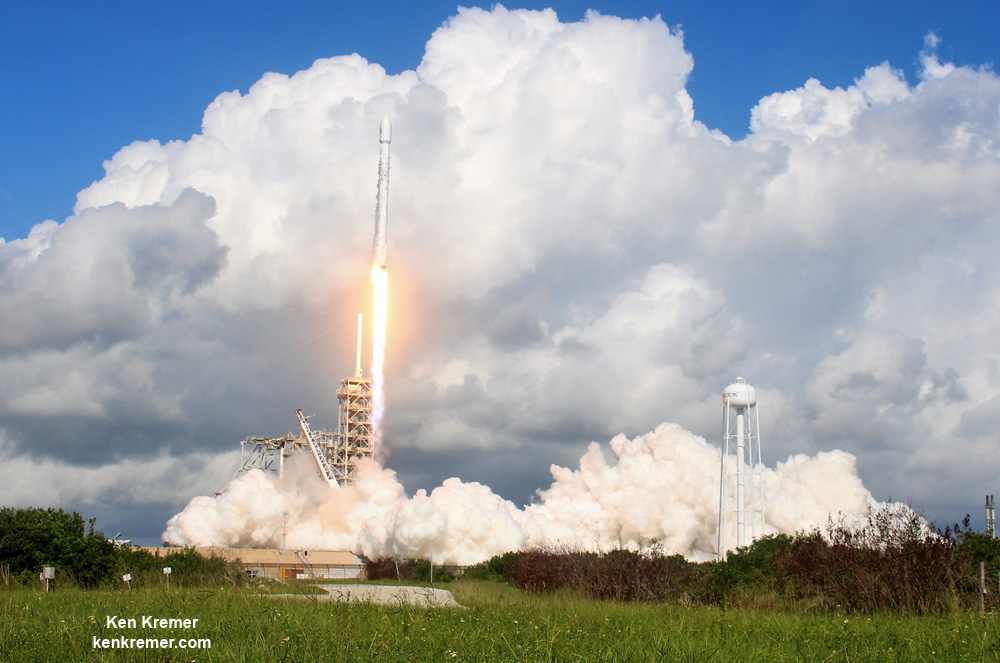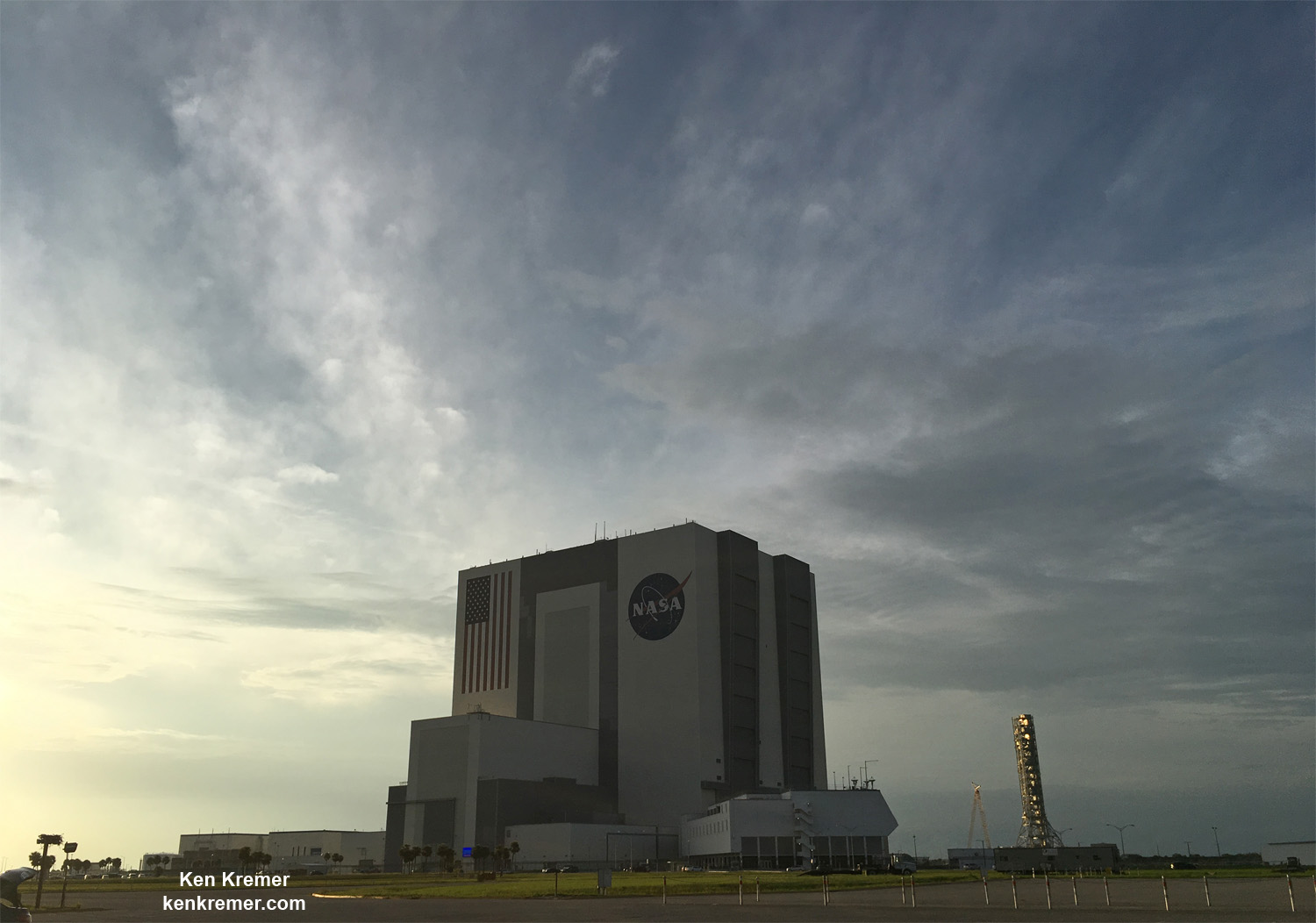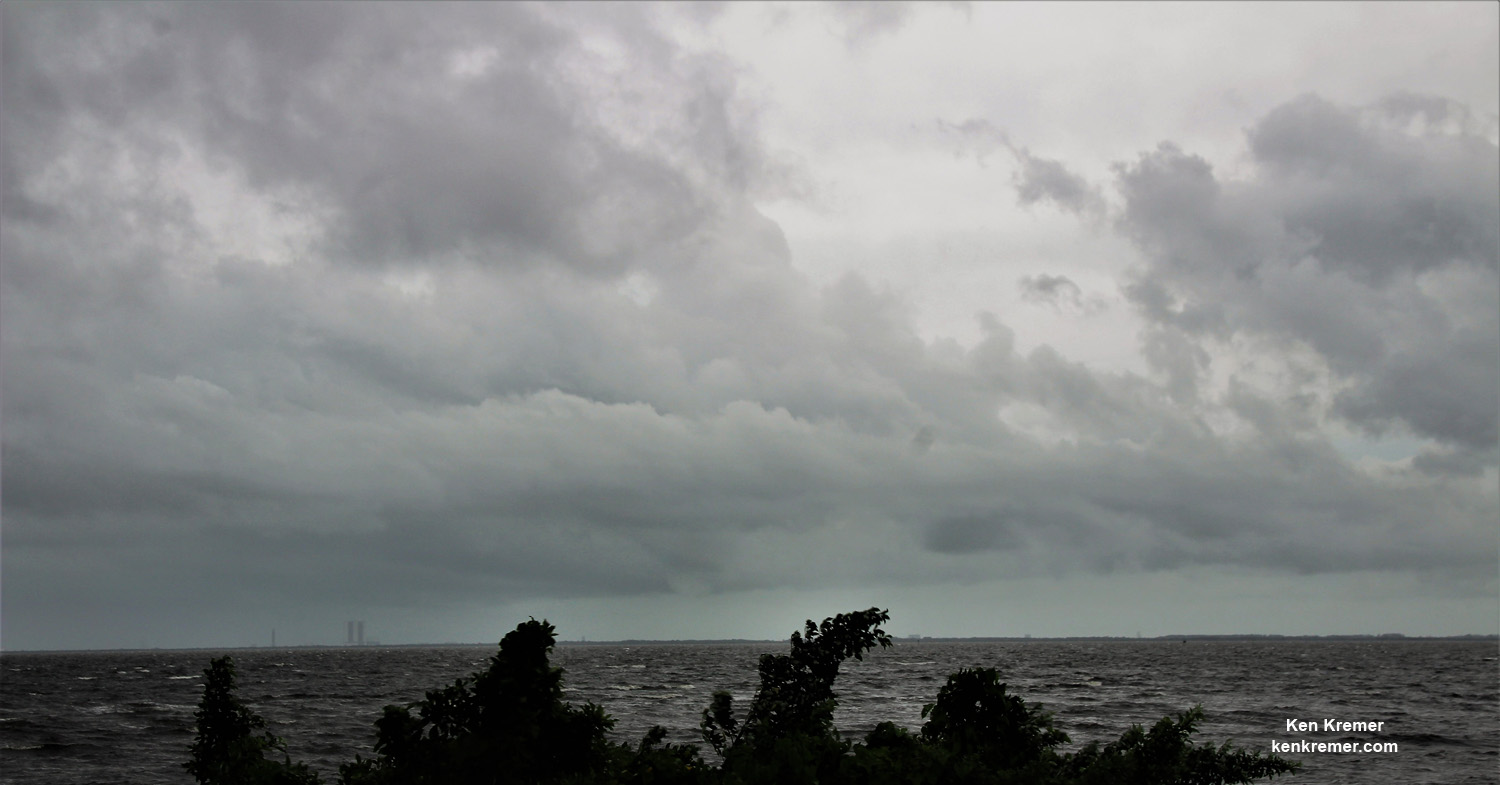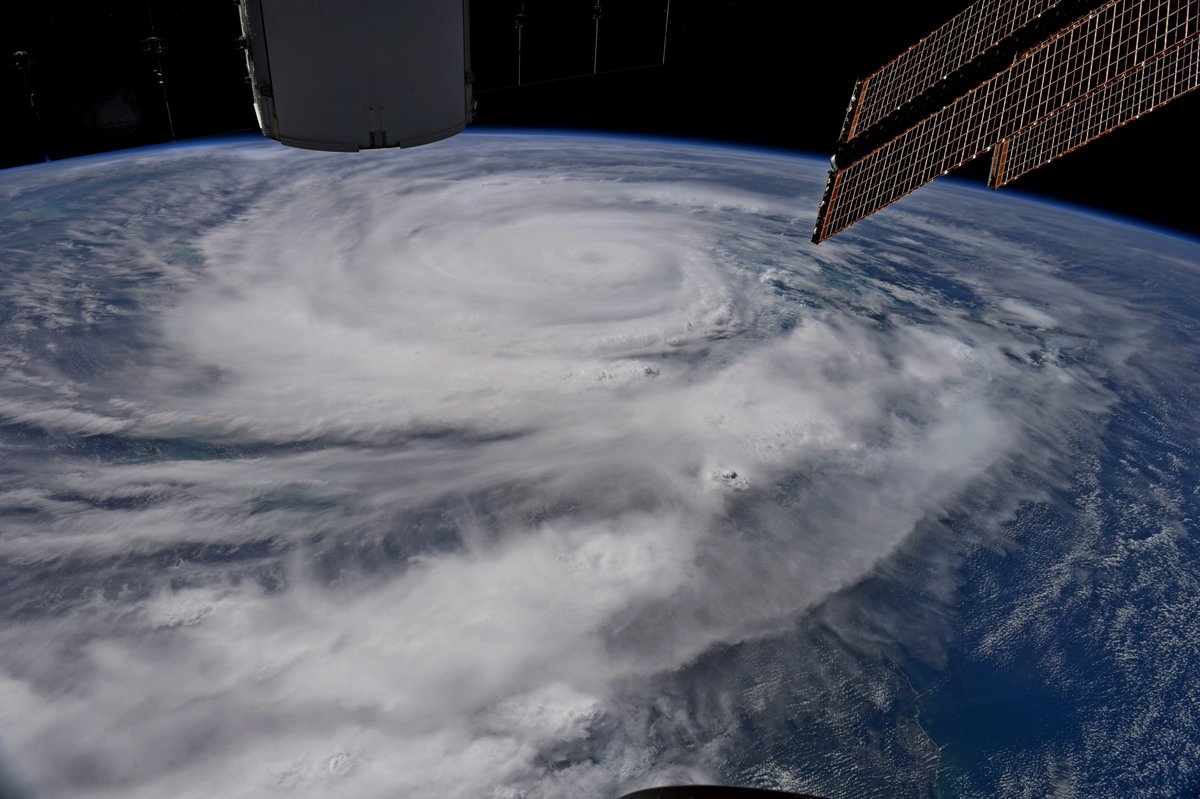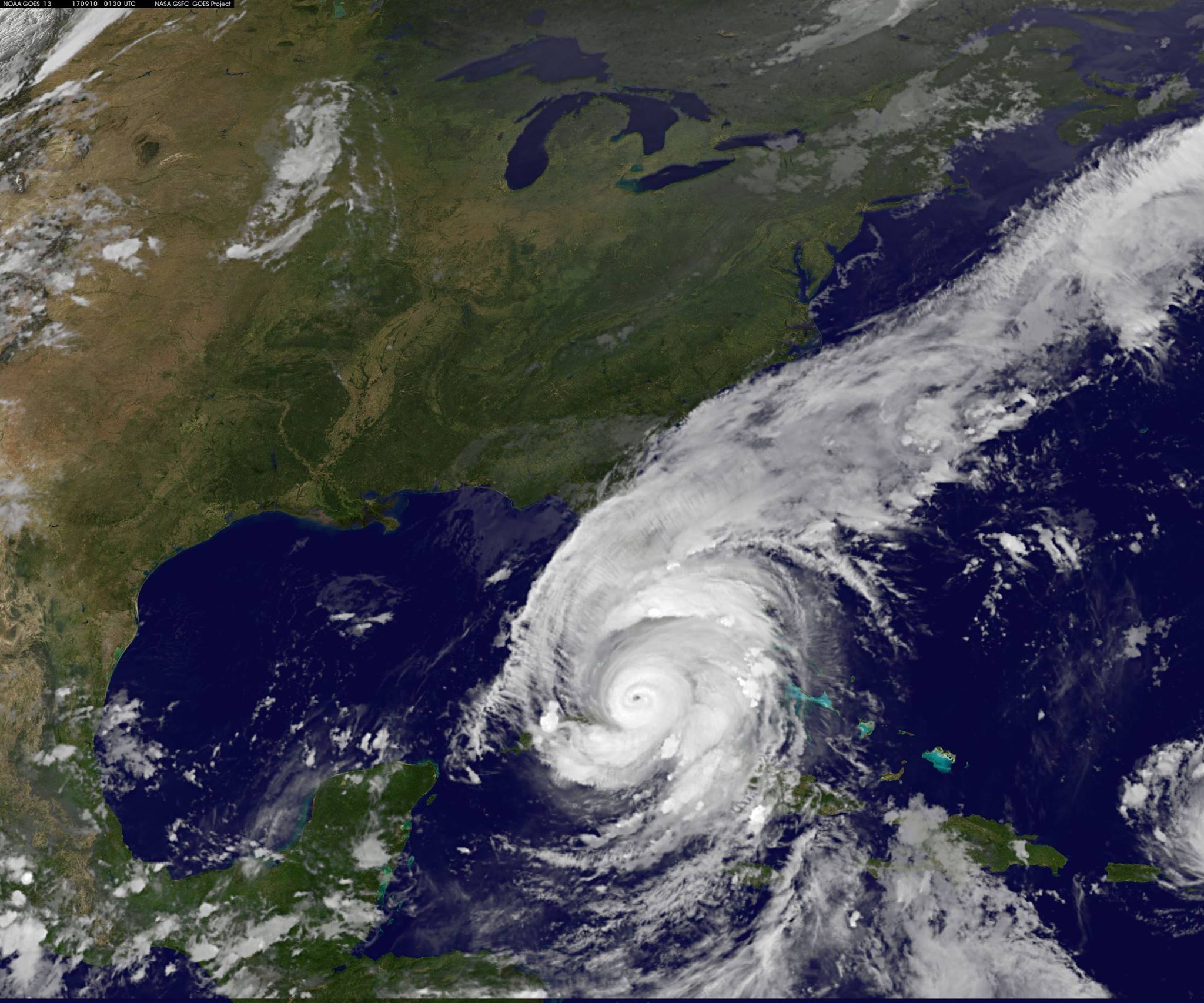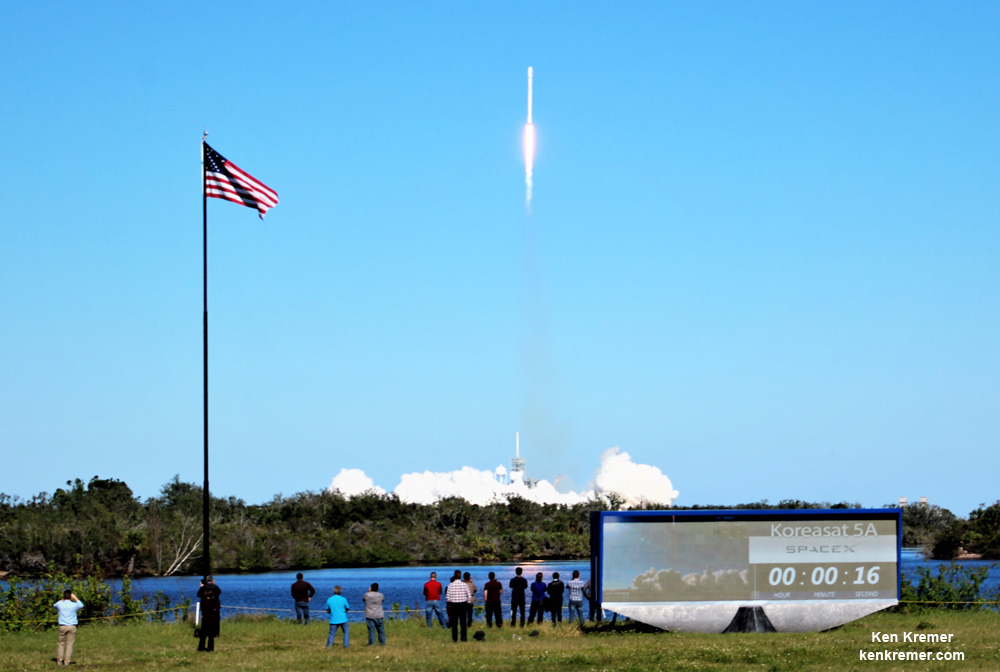
KENNEDY SPACE CENTER, FL – SpaceX delivered a spectacular Halloween eve delight with today’s Falcon 9 launch of a Korean HDTV satellite that lit up the Florida Space Coast skies with a glow that delighted kids of all ages and ghouls alike and put an end at last for today to the atrocious wet and windy weather afflicting the Spaceport region.
The SpaceX Falcon 9 blasted off mid-afternoon Monday Oct. 30 with the private KoreaSat-5A telecomsat mission right at the opening of the launch window at 3:34 p.m. EDT (1934 GMT) from seaside Launch Complex 39A at NASA’s Kennedy Space Center in Florida.
Eight and a half minutes after liftoff the 15 story tall first stage booster nailed another rocket assisted touchdown on the OCISLY droneship pre-positioned several hundred miles off shore of Cape Canaveral in the Atlantic Ocean.
Today’s mission marks the 16th launch by SpaceX this year, the 2nd this month by the new space firms Falcon 9 rocket from Florida’s Spaceport, and the third overall counting another liftoff from Vandenberg AFB, Calif. – thus maintaining an absolutely torrid and record setting yearly launch pace.
The launch was broadcast live on a SpaceX dedicated webcast.
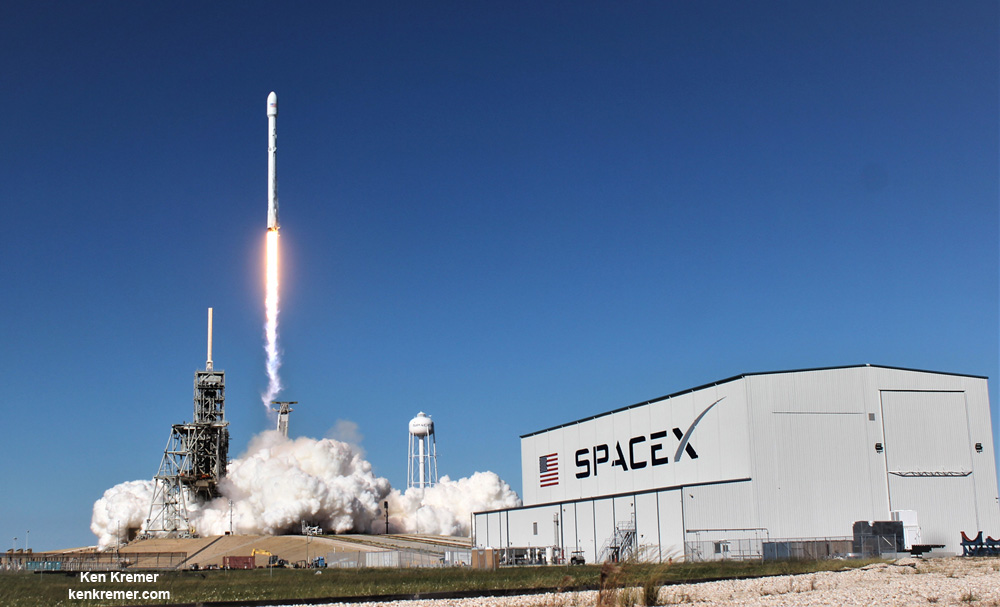
Florida finally fulfilled its billing as the ‘Sunshine State’ with truly superb afternoon weather for Monday afternoon’s liftoff of a SpaceX Falcon 9 with its first Korean satellite customer – and the decent weather outlook looks like it will extend into Tuesdays Halloween trick or treating for the local kiddies and their imaginative costumes.
The two stage 229-foot-tall (70-meter-tall) Falcon 9 rocket shined at sunrise this morning and throughout the countdown and fueling process fed the falcon with RP-1 and liquid oxygen propellant powering the rockets nine first stage Merlin 1D engines.
Altogether the Merlin 1D engine delivered a powerful liftoff punch that was far more than a Halloween ‘boo’ as the engines ignited with 1.7 million pounds of liftoff thrust.
As the Falcon 9 roared off launch pad 39A a rumbling thunder reverberated across the space coast region and beyond that brought broad smiles of glee to spectators faces packing local area beaches and hotels and quickly dispatched wicked ghouls to their graves.
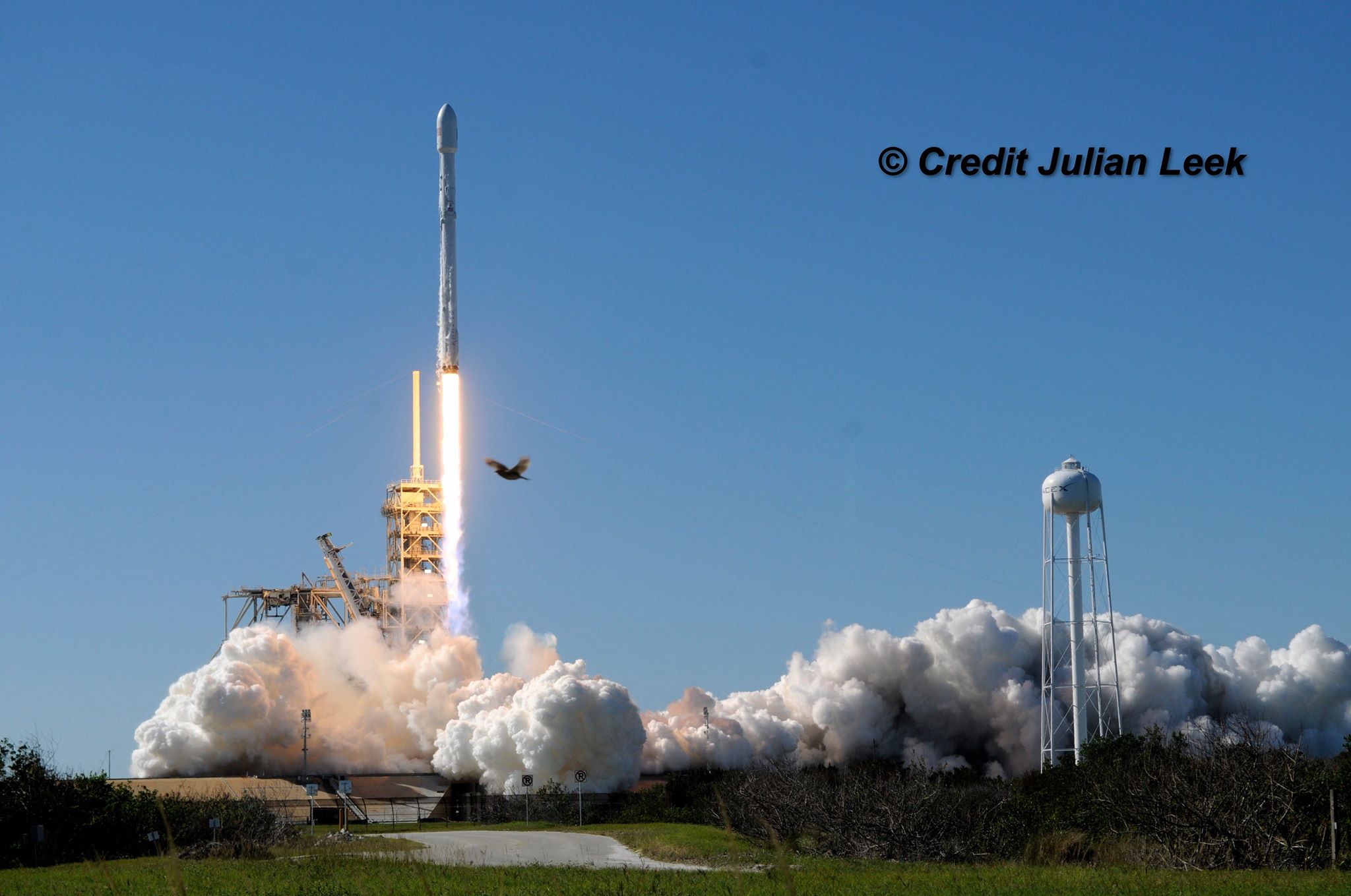
Trick or treaters will have a fine Halloween indeed following SpaceX’s thunderous rocket launch into picture perfect clear blue skies that were set of fire as the rocket vaulted off the pad and arched over eastwards to the African continent as it accelerated to the heavens.
The SpaceX Falcon 9 successfully delivered Koreasat-5A to a geostationary transfer orbit (GTO).
Satellite deployment took place as planned 35 minutes after launch as seen on the webcast.
“Successful deployment of Koreasat-5A to geostationary transfer orbit confirmed,” said SpaceX.
The launch was also accompanied by a successful attempt to recover the 156 foot tall first stage booster after completing its primary satellite delivery mission task.
Choppy seas from Tropical Storm Phillipe made the sea landing even more challenging.
SpaceX engineers guided it to a landing on the tiny OCISLY drone ship for an upright and intact pinpoint soft landing touchdown on the ocean going platform prepositioned off shore in the Atlantic Ocean – some 8 minutes after blastoff.
OCISLY or “Of Course I Still Love You” left Port Canaveral several days ahead of the planned Oct. 30 launch and was prepositioned in the Atlantic Ocean several hundred miles (km) off the US East coast, awaiting the boosters approach and pinpoint propulsive soft landing.
“Falcon 9 first stage has landed on the Of Course I Still Love You droneship.” announced SpaceX.
“A little toasty, but stage one is certainly still intact on the droneship.”
A small fire broke out on the Falcon 9 atop the droneship after landing as seen on the webcast but it was quickly extinguished.
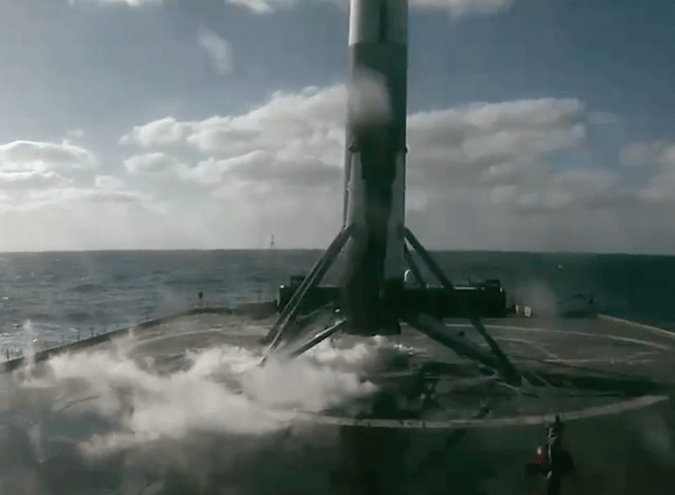
The nearly two ton commercial KoreaSat-5A satellite will provide Direct to Home (DTH) broadcasting, maritime, internet and other services to the Asian region centering around South Korea.
It has a 15 year design lifetime.
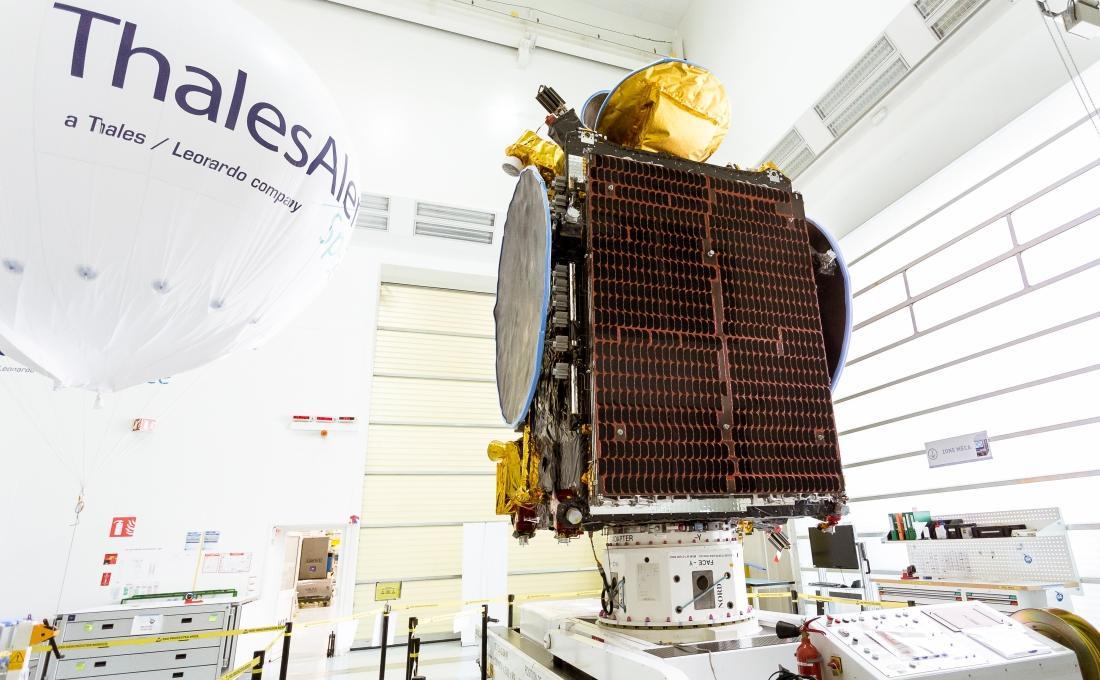
KoreaSat-5A was built by Thales Alenia Space and launched by SpaceX under a commercial contract for South Korean operator KTSAT (a KT Corporation company) using a freshly built first stage booster.
KTSAT is South Koreas sole satellite service provider.
Of course North Koreans have no access to any of these services as they are forbidden under the regime of Kim Jong Un with severe penalties for any violators.
The satellite was attached to the booster encapsulated in the nose cone last Friday after engineers successfully completed the routine but required static hot fire test of the first stage engines last Thursday, Oct 26.
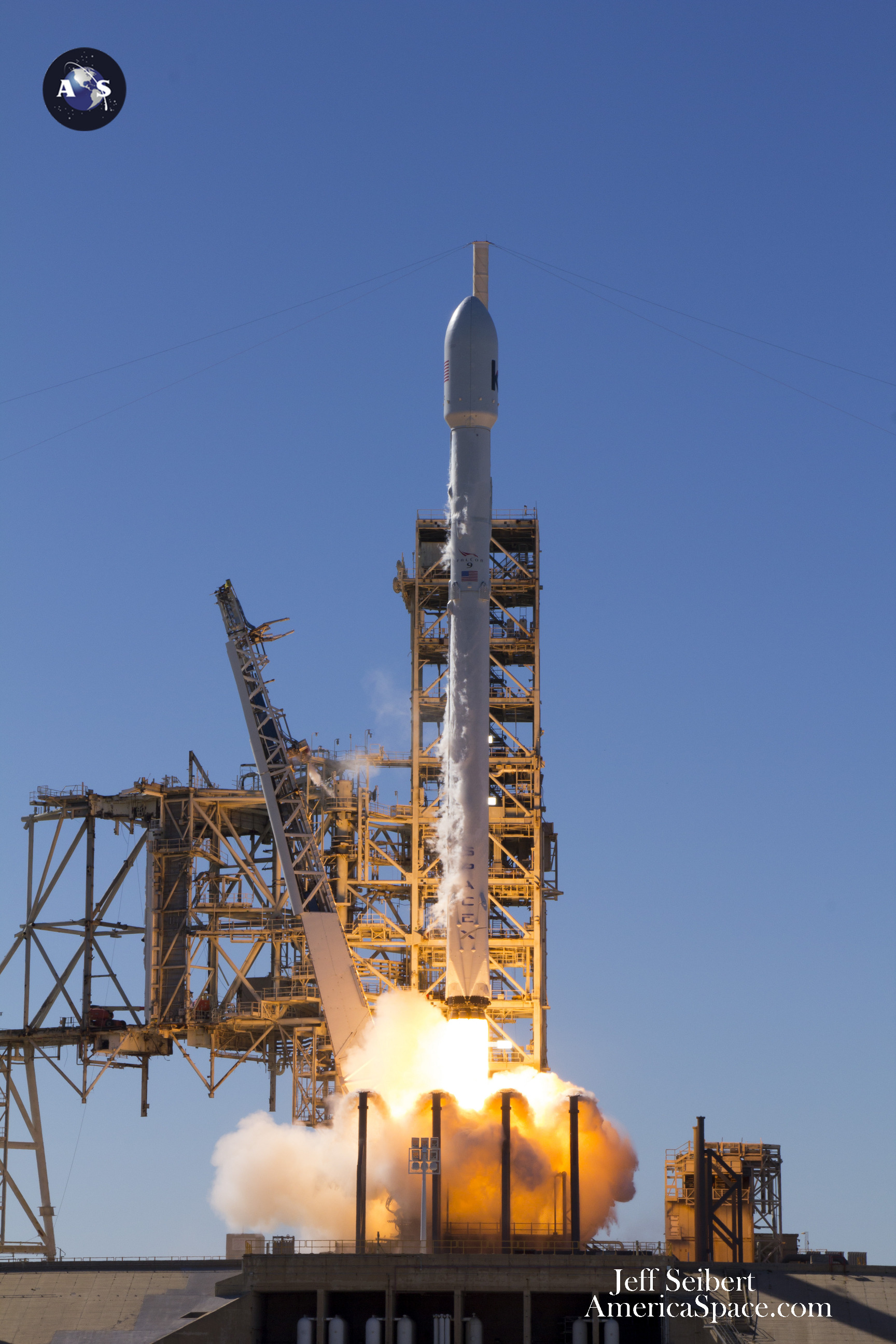
Koreasat-5A was built by prime contractor, Thales Alenia Space, responsible for the design, production, testing and ground delivery. It arrived at the Florida launch base on Oct. 5 for integration with the Falcon 9 rocket.
The 3,700 kg (8,160 lb) satellite is equipped with 36 Ku-band transponders and based on Thales Alenia Space’s new-generation Spacebus 4000B2 platform. It will replace Koreasat 5 launched a decade ago in 2006.
The solar panels provide a payload power of approximately 6.5 kW. It will be positioned at 113° East and provide coverage for Indochina, Japan, Korea, the Philippines and the Middle East including Direct to Home (DTH) services.
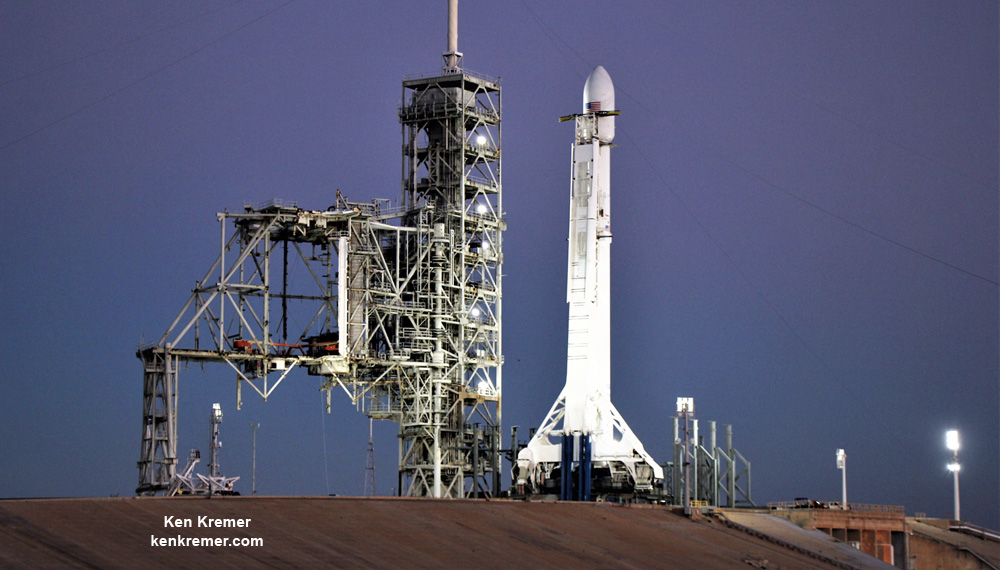
Pad 39A has been repurposed by SpaceX from its days as a NASA shuttle launch pad.
To date SpaceX has now accomplished 19 successful landings of a recovered Falcon 9 first stage booster by land and by sea.
The KoreaSat-5A booster is expected back into Port Canaveral later this week – and the public can watch the sailing action.
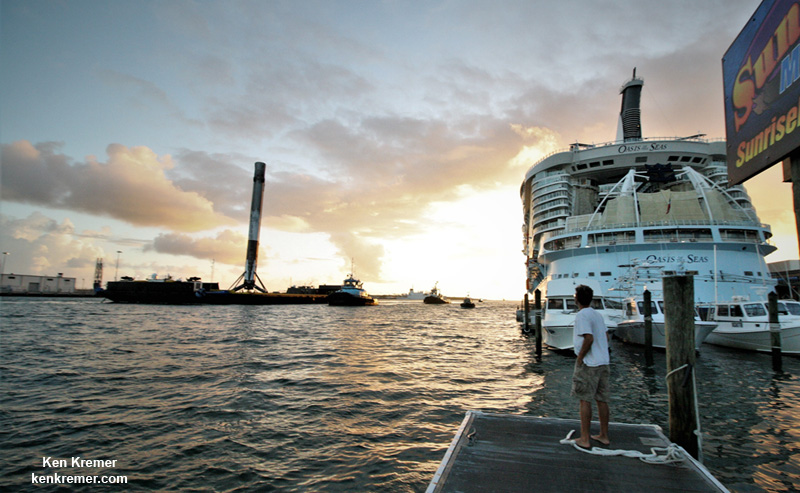
The first stage from this months SES-11 launch arrived back into Port Canaveral, FL on top of the OCISLY droneship on Oct. 15. The SES-11 comsat launched on Oct. 11.
Watch for Ken’s continuing onsite coverage of SpaceX KoreaSat-5A & SES-11, ULA NROL-52 and NASA and space mission reports direct from the Kennedy Space Center and Cape Canaveral Air Force Station, Florida.
Stay tuned here for Ken’s continuing Earth and Planetary science and human spaceflight news.
Ken Kremer
